05-webpack5中的事件调度系统和NormalModuleFactary核心逻辑
1. 书接上回,从 this.factorizeQueue.add(options, callback); 开始
不是很清楚上下文的兄弟,可以去看下我之前写的 (源码篇01)浅析webpack5中Compiler中重要的hook调用过程。
此文比较干,各位读者开始阅读前,请准备好
瓜子,可乐,矿泉水,好好享受阅读源码的乐趣。

1.1 通过 factorizeQueue 了解 AsyncQueue
那么 这个 this.factorizeQueue 指的是什么呢?谁来创建的呢?首先此处的 this 指的是 Compilation 的 实例对象,那就去 Compilation 查找,全局搜索一下 Compilation.js 文件,找到了,代码如下(中文注释是我加的):
/** @type {AsyncQueue<Module, Module, Module>} 进程依赖项队列 */
this.processDependenciesQueue = new AsyncQueue({
name: "processDependencies",
parallelism: options.parallelism || 100,
processor: this._processModuleDependencies.bind(this)
});
/** @type {AsyncQueue<Module, string, Module>} 添加模块队列 */
this.addModuleQueue = new AsyncQueue({
name: "addModule",
parent: this.processDependenciesQueue,
getKey: module => module.identifier(),
processor: this._addModule.bind(this)
});
/** @type {AsyncQueue<FactorizeModuleOptions, string, Module | ModuleFactoryResult>} 分解队列 */
this.factorizeQueue = new AsyncQueue({
name: "factorize",
parent: this.addModuleQueue,
processor: this._factorizeModule.bind(this)
});
/** @type {AsyncQueue<Module, Module, Module>} 构建队列 */
this.buildQueue = new AsyncQueue({
name: "build",
parent: this.factorizeQueue,
processor: this._buildModule.bind(this)
});
/** @type {AsyncQueue<Module, Module, Module>} 重新构建的队列 */
this.rebuildQueue = new AsyncQueue({
name: "rebuild",
parallelism: options.parallelism || 100,
processor: this._rebuildModule.bind(this)
});
你会发现好家伙,这不仅仅只有一个队列呀,这里是有一堆的队列。但是都是 AsyncQueue 创建的不同名称的实例。 那根据 this.factorizeQueue.add(options, callback); 我们下一步就是去看 AsyncQueue 中的 add 方法了。
1.2 深入 AsyncQueue 中的 add 方法
在深入了解 add 之前,我们先要了解 它的 构造函数都需要哪些参数,以便我们更好的理解其内部的工作原理。
constructor({ name, parallelism, parent, processor, getKey }) {
this._name = name;
this._parallelism = parallelism || 1;
this._processor = processor;
this._getKey =
getKey || /** @type {(T) => K} */ (item => /** @type {any} */ (item));
/** @type {Map<K, AsyncQueueEntry<T, K, R>>} */
this._entries = new Map();
/** @type {ArrayQueue<AsyncQueueEntry<T, K, R>>} */
this._queued = new ArrayQueue();
/** @type {AsyncQueue<any, any, any>[]} */
this._children = undefined;
this._activeTasks = 0;
this._willEnsureProcessing = false;
this._needProcessing = false;
this._stopped = false;
this._root = parent ? parent._root : this;
if (parent) {
if (this._root._children === undefined) {
this._root._children = [this];
} else {
this._root._children.push(this);
}
}
this.hooks = {
/** @type {AsyncSeriesHook<[T]>} */
beforeAdd: new AsyncSeriesHook(["item"]),
/** @type {SyncHook<[T]>} */
added: new SyncHook(["item"]),
/** @type {AsyncSeriesHook<[T]>} */
beforeStart: new AsyncSeriesHook(["item"]),
/** @type {SyncHook<[T]>} */
started: new SyncHook(["item"]),
/** @type {SyncHook<[T, Error, R]>} */
result: new SyncHook(["item", "error", "result"])
};
this._ensureProcessing = this._ensureProcessing.bind(this);
}
入参如下:name, parallelism, parent, processor, getKey。name 字段是绑在实例身上的 _name,_parallelism 先忽略,parent 属性是比较重要的, 有 parent属性的情况下,实例的 this._root 指向的是 父级的 parent._root,否则指向的就是实例本身。并且会把自身丢进 父级的 this._root._children 里。
(另外在此构造函数里的
hooks就是给当前实例绑定一些执行周期的钩子,比较容易扩展,都是老 webpack 玩家了,这里就不过多的介绍了。这里要注意 新建实例的_willEnsureProcessing,_needProcessing和_stopped默认值都是false状态。)
分析一下 1.1 中的代码:
this.addModuleQueue = new AsyncQueue({
name: "addModule",
parent: this.processDependenciesQueue,
getKey: module => module.identifier(),
processor: this._addModule.bind(this)
});
this.factorizeQueue = new AsyncQueue({
name: "factorize",
parent: this.addModuleQueue,
processor: this._factorizeModule.bind(this)
});
this.buildQueue = new AsyncQueue({
name: "build",
parent: this.factorizeQueue,
processor: this._buildModule.bind(this)
});
- this.addModuleQueue 中的 _root 指向的是 this.processDependenciesQueue._root,也就是 processDependenciesQueue 自身,
- this.factorizeQueue 中的 _root 指向的是 this.addModuleQueue._root,而 this.addModuleQueue._root 指向的是 processDependenciesQueue
- this.buildQueue 中的 _root 指向的是 this.factorizeQueue._root,而 this.factorizeQueue._root 指向的是 processDependenciesQueue
这意味着上面创建的队列中的 父子关系是如下图的:
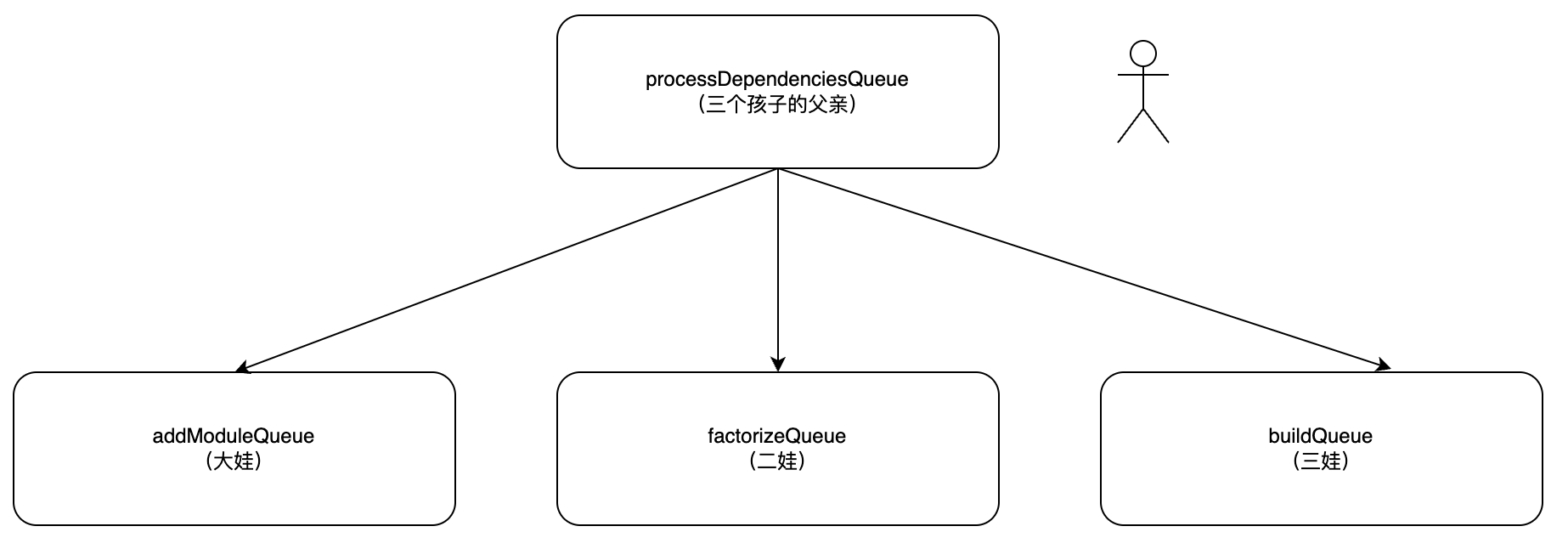
知道了父子关系以后,就开始看 add 函数具体执行了什么操作,直接断点到这里,看下入参都是什么?(记不着的兄弟去看我前一篇文章。)
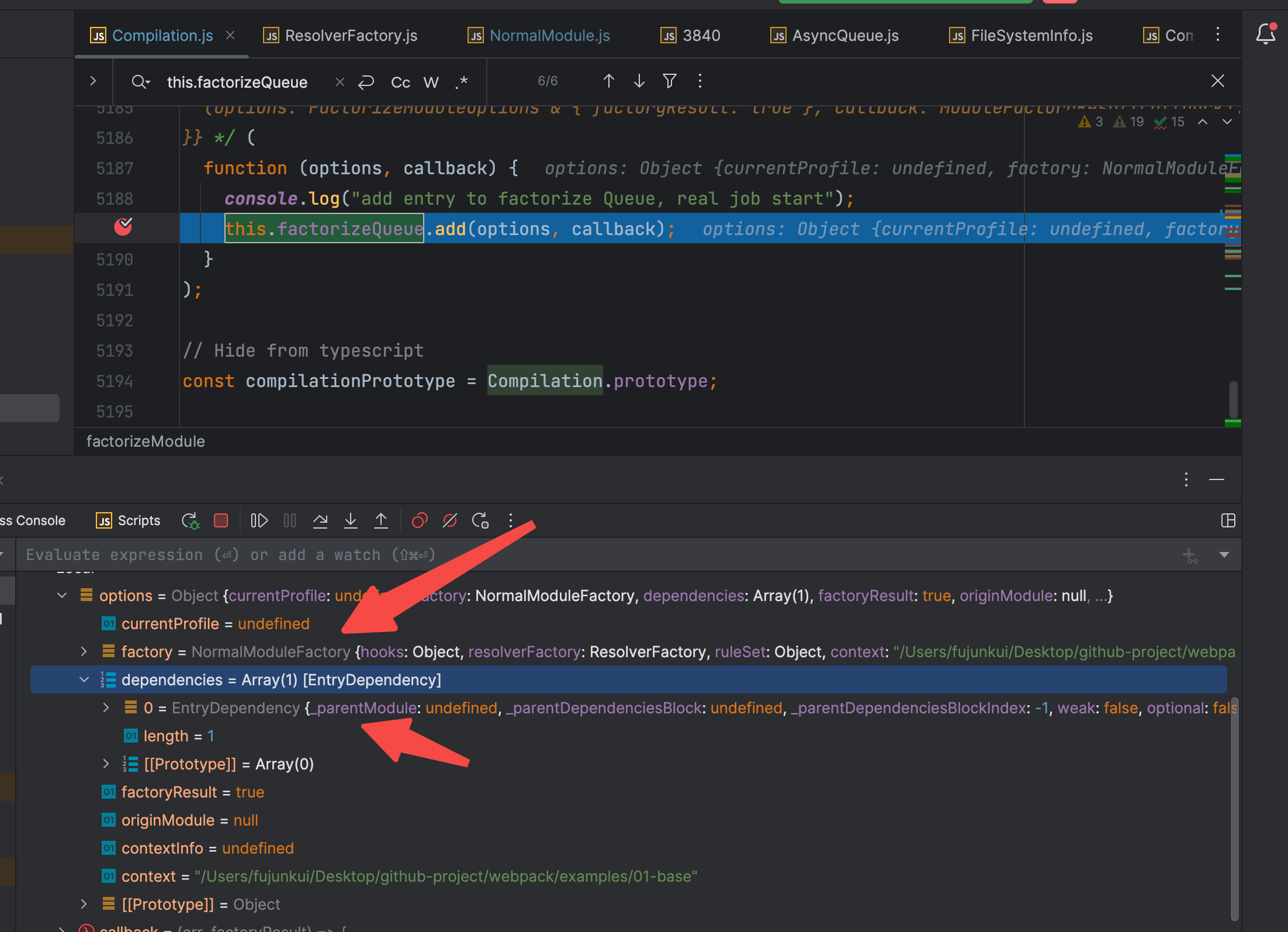
进入 add 函数内部。

大致的逻辑就是 判断一下 this._stopped 当前的实例队列是不是暂停的状态,是暂停的状态就 直接 callback 抛出错误。 那核心的步骤就在 this.hooks.beforeAdd.callAsync这个 hook 了,老规矩,debug 这个 hook 看一下有哪些 监听者。
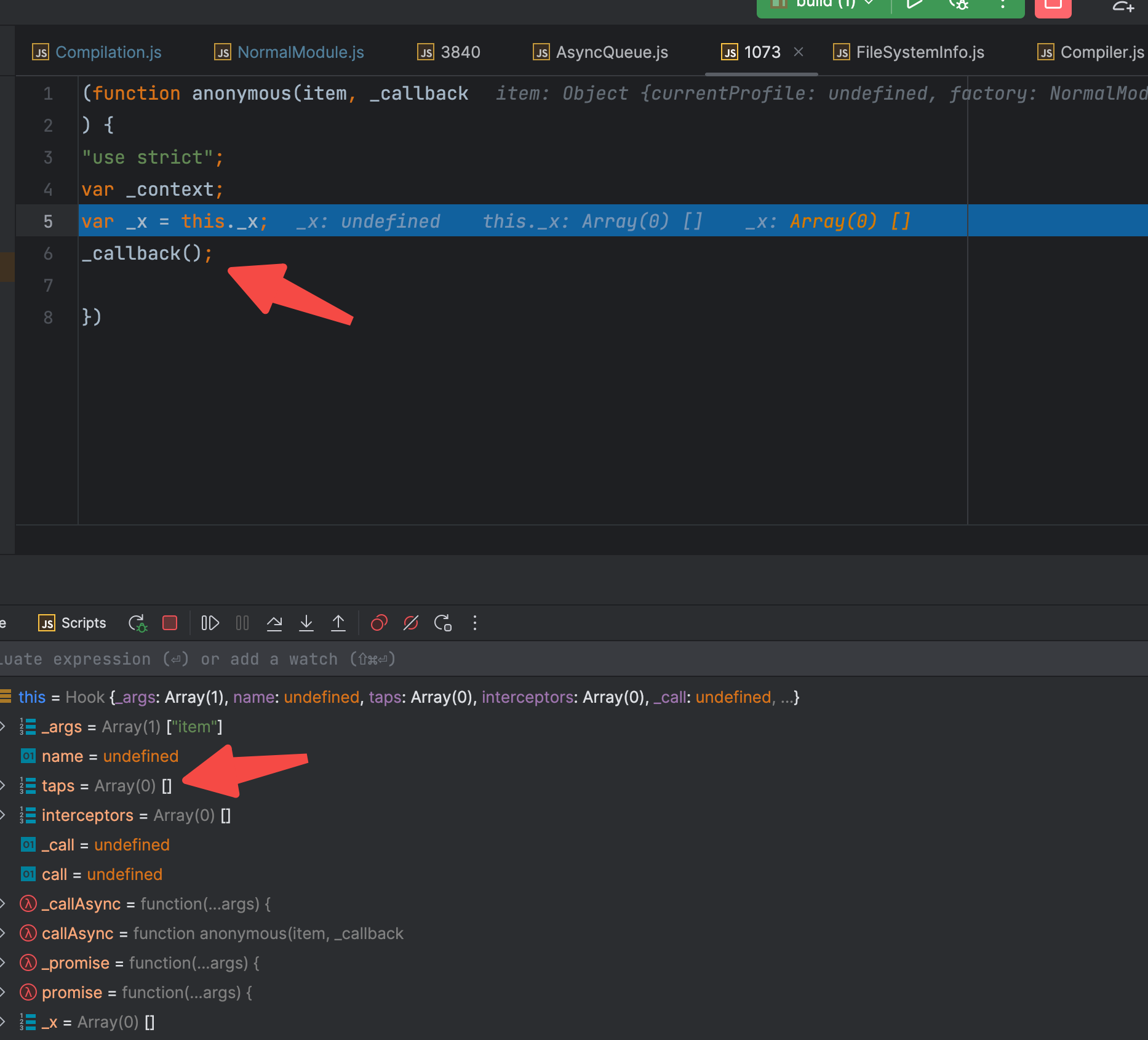
发现这个 hook 没有一个监听者,直接执行了本身的 callback 函数,继续 debug 下去。进入 hook 的内部,
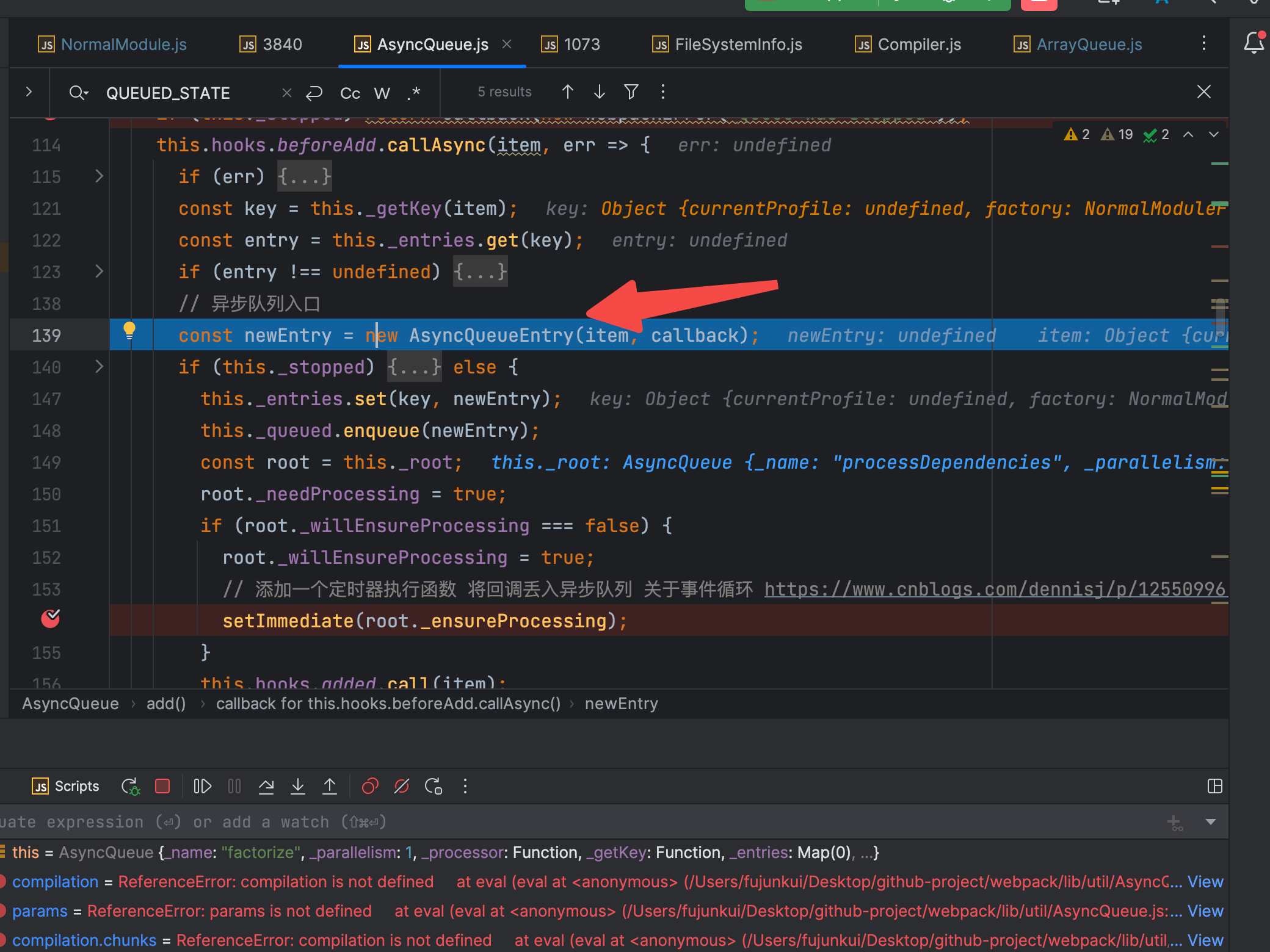
部分没有走到的逻辑 直接跳过,根据 item 和 callback 实例化AsyncQueueEntry 对象,并赋值给 newEntry变量。 稍微看下 AsyncQueueEntry 类。
const QUEUED_STATE = 0;
const PROCESSING_STATE = 1;
const DONE_STATE = 2;
class AsyncQueueEntry {
/**
* @param {T} item the item
* @param {Callback<R>} callback the callback
*/
constructor(item, callback) {
this.item = item;
/** @type {typeof QUEUED_STATE | typeof PROCESSING_STATE | typeof DONE_STATE} */
this.state = QUEUED_STATE;
this.callback = callback;
/** @type {Callback<R>[] | undefined} */
this.callbacks = undefined;
this.result = undefined;
/** @type {WebpackError | undefined} */
this.error = undefined;
}
}
可以看到对于 AsyncQueueEntry 的this.state字段有 3 个状态可选(看 jsDoc 部分,也就是 this.state 的上一行),初始创建的 实例是 QUEUED_STATE 状态,也就是排队状态。
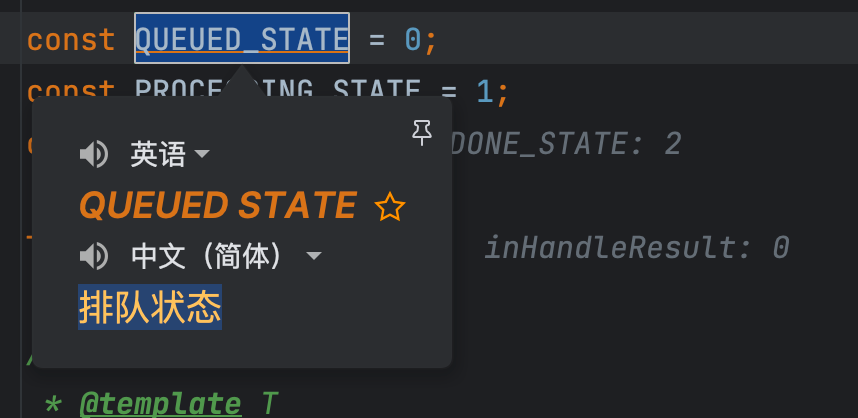
大致知道了 newEntry 变量承载了什么东西,继续 debug 下一步。 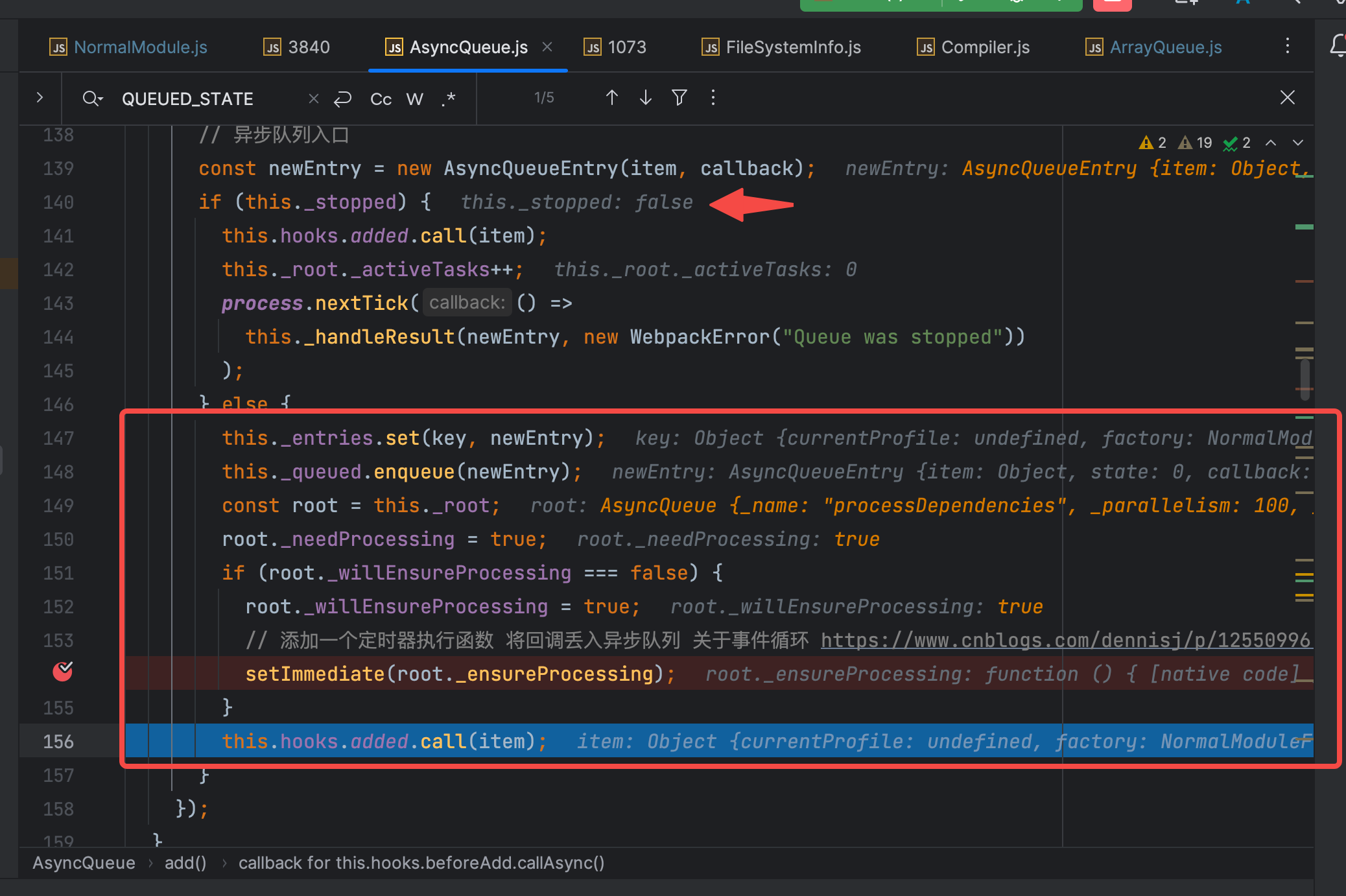
没有进入 if 语句的 成功分支,走了 else 部分(也就是红色圈中部分)。此处的代码量比较少,但是比较核心。 首先看 148 行 this._queued.enqueue(newEntry); 就是把当前的 newEntry 实例 丢入到 自身的 队列里。 接下来 149 行,找到该实例的父级 也就是 _name 为 processDependencies 的实例。在 150 行 将其父级的 _needProcessing 变更为 true, 因为默认创建的实例的 _willEnsureProcessing 的状态为 false,所以此处会走进 151 行的判断逻辑,去执行 152-154 行的代码,将父级(processDependencies)的 _ensureProcessing 丢进定时器里(注意是父级的,异步函数会在同步函数执行完毕以后调用,另外异步函数也是有优先级之分的哈,不一定是最先丢进去的,最先执行)。 继续 debug, 触发 156 的 hook 钩子。 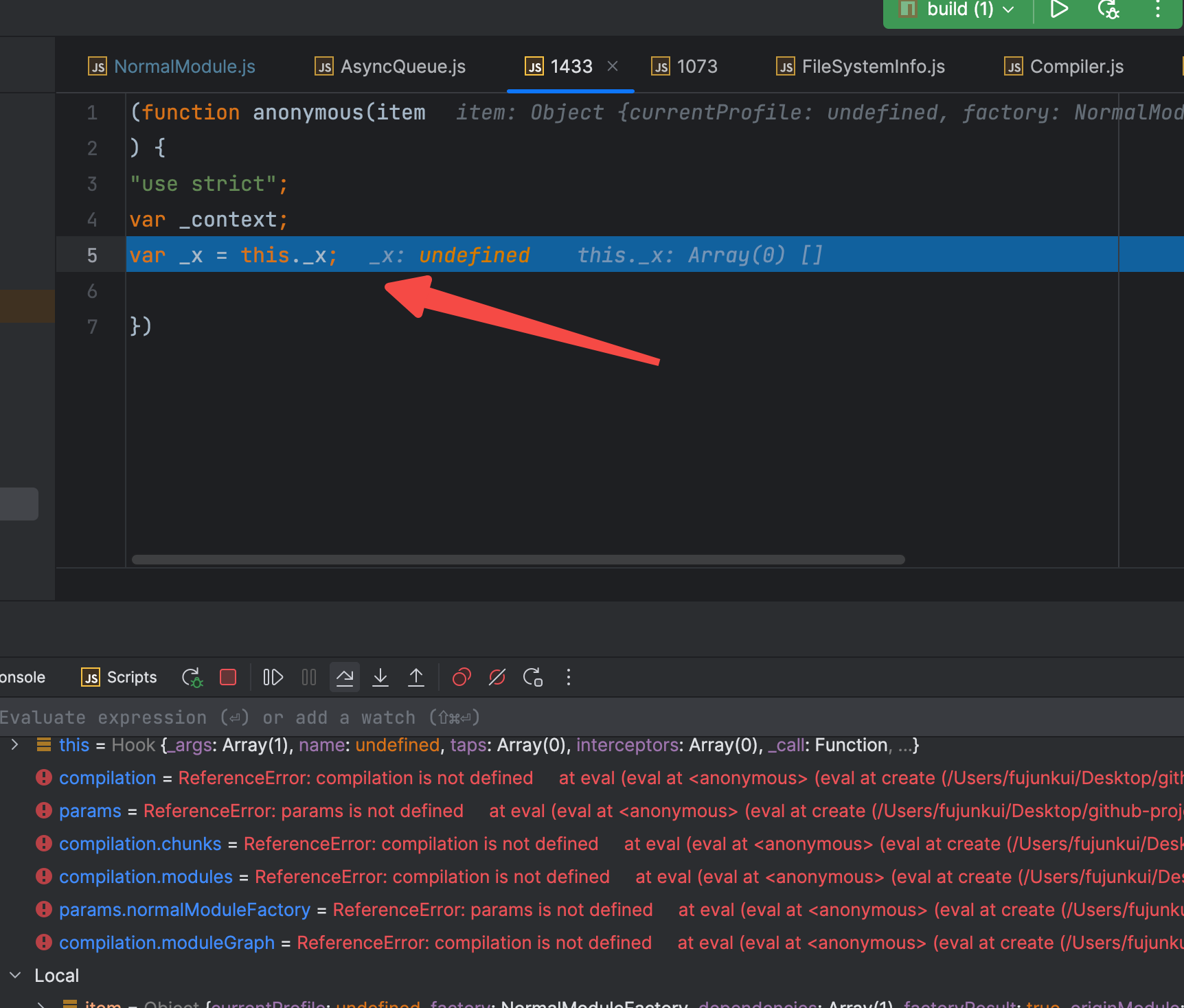 这个钩子真可怜,没有人注册监听事件。(就不放 s 图了,上次放的 s 图导致违规了)。
这个钩子真可怜,没有人注册监听事件。(就不放 s 图了,上次放的 s 图导致违规了)。
至此同步的函数执行完毕了,别忘了之前还向定时器里丢了一个异步的 父级(processDependencies)的 _ensureProcessing 方法,下一步直接断点蹲在 _ensureProcessing处。
1.3 浅浅的总结一下~
- webpack 中的
Compilation实例,创建了 4 个有父子关系的异步队列 - 最先开始 工作的是
factorizeQueue队列,执行了factorizeQueue队列的 add 方法。 - 在 add 方法中,将
factorizeQueue队列的父级(processDependencies)队列的_ensureProcessing方法放入了定时器中。 - 至此,同步函数执行完毕,开始执行
父级(processDependencies)的_ensureProcessing的方法。
2. 异步队列要开始了
2.1 执行 processDependencies 队列的 _ensureProcessing 方法
直接断点到 _ensureProcessing 方法,验证一下猜想。
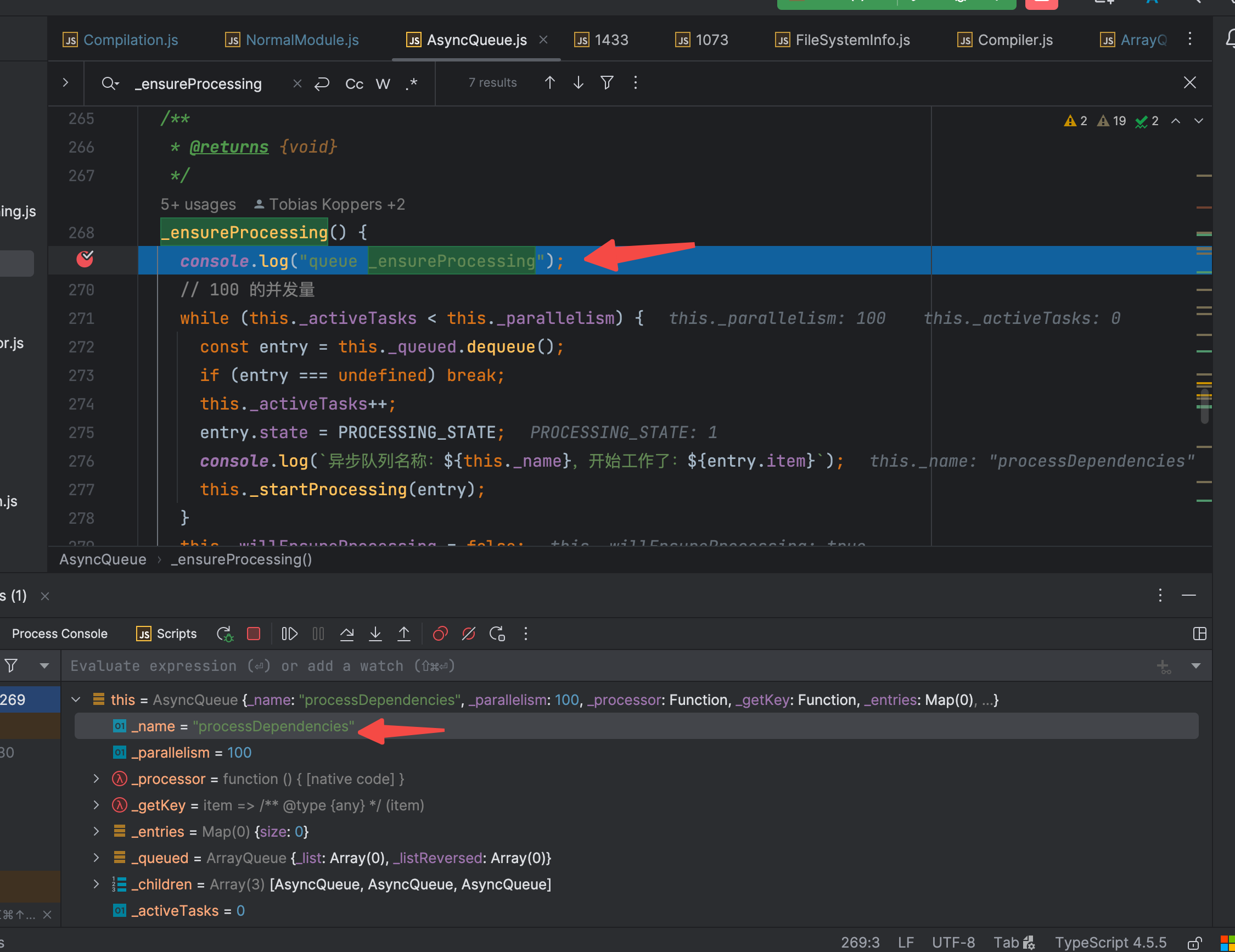
相关代码贴出来
_ensureProcessing() {
console.log("queue _ensureProcessing");
// 100 的并发量
while (this._activeTasks < this._parallelism) {
const entry = this._queued.dequeue();
if (entry === undefined) break;
this._activeTasks++;
entry.state = PROCESSING_STATE;
console.log(`异步队列名称:${this._name},开始工作了:${entry.item}`);
this._startProcessing(entry);
}
this._willEnsureProcessing = false;
if (this._queued.length > 0) return;
if (this._children !== undefined) {
// this._children 是之前创建的 addModule factorize 和 build的 AsyncQueue
// lib/Compilation.js 的 944 行
for (const child of this._children) {
while (this._activeTasks < this._parallelism) {
const entry = child._queued.dequeue();
if (entry === undefined) break;
this._activeTasks++;
entry.state = PROCESSING_STATE;
child._startProcessing(entry);
}
if (child._queued.length > 0) return;
}
}
if (!this._willEnsureProcessing) this._needProcessing = false;
}
开始分析流程,this 指向的是 processDependencies 的实例队列,而在上一步是给它的子队列factorizeQueue里放入了东西newEntry。
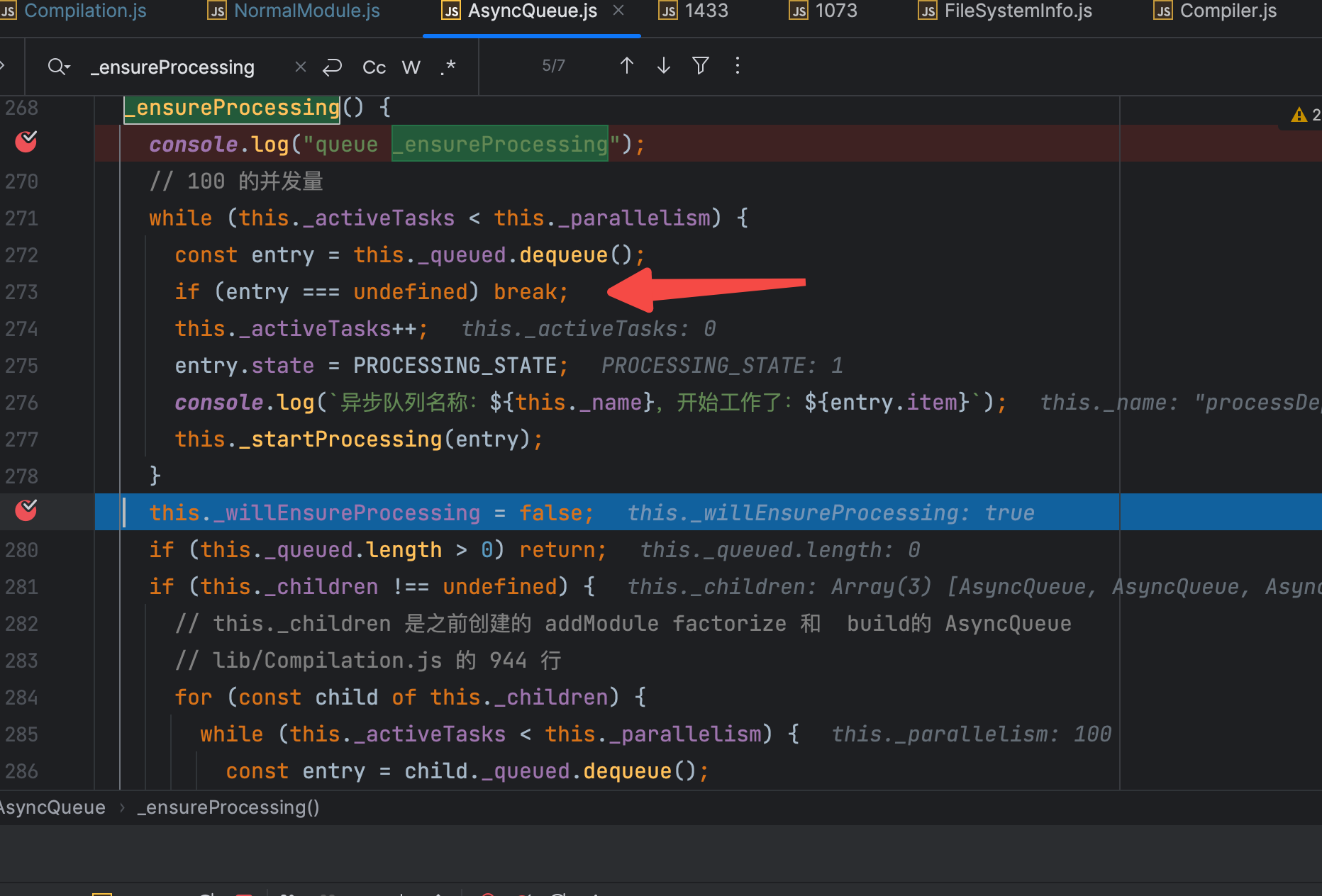
所以会直接从 273 行,break 出来,开始执行 289行,将自己的 _willEnsureProcessing 状态改为了 false。
通过之前提到的父子关系(老父亲带着 3 个儿子),我们继续看 281 行的代码。很显然是可以走进这个条件判断的,继续 debug。
for (const child of this._children) {
while (this._activeTasks < this._parallelism) {
const entry = child._queued.dequeue();
if (entry === undefined) break;
this._activeTasks++;
entry.state = PROCESSING_STATE;
child._startProcessing(entry);
}
if (child._queued.length > 0) return;
}
这块代码的主要含义还是,遍历子队列,并取出相关的任务 赋值给
entry变量,如果entry不存在,说明子队列为空,直接 break,开始遍历下一个子队列。如果子队列有数据,对父级当前进行的任务数量加一(this._activeTasks++;),然后把相关任务的状态改为PROCESSING_STATE,也就是任务进行中,调用子队列的_startProcessing把任务传入。
毫无疑问的是,我们的 factorizeQueue 子队列中存在任务newEntry,继续 debug 验证猜想。 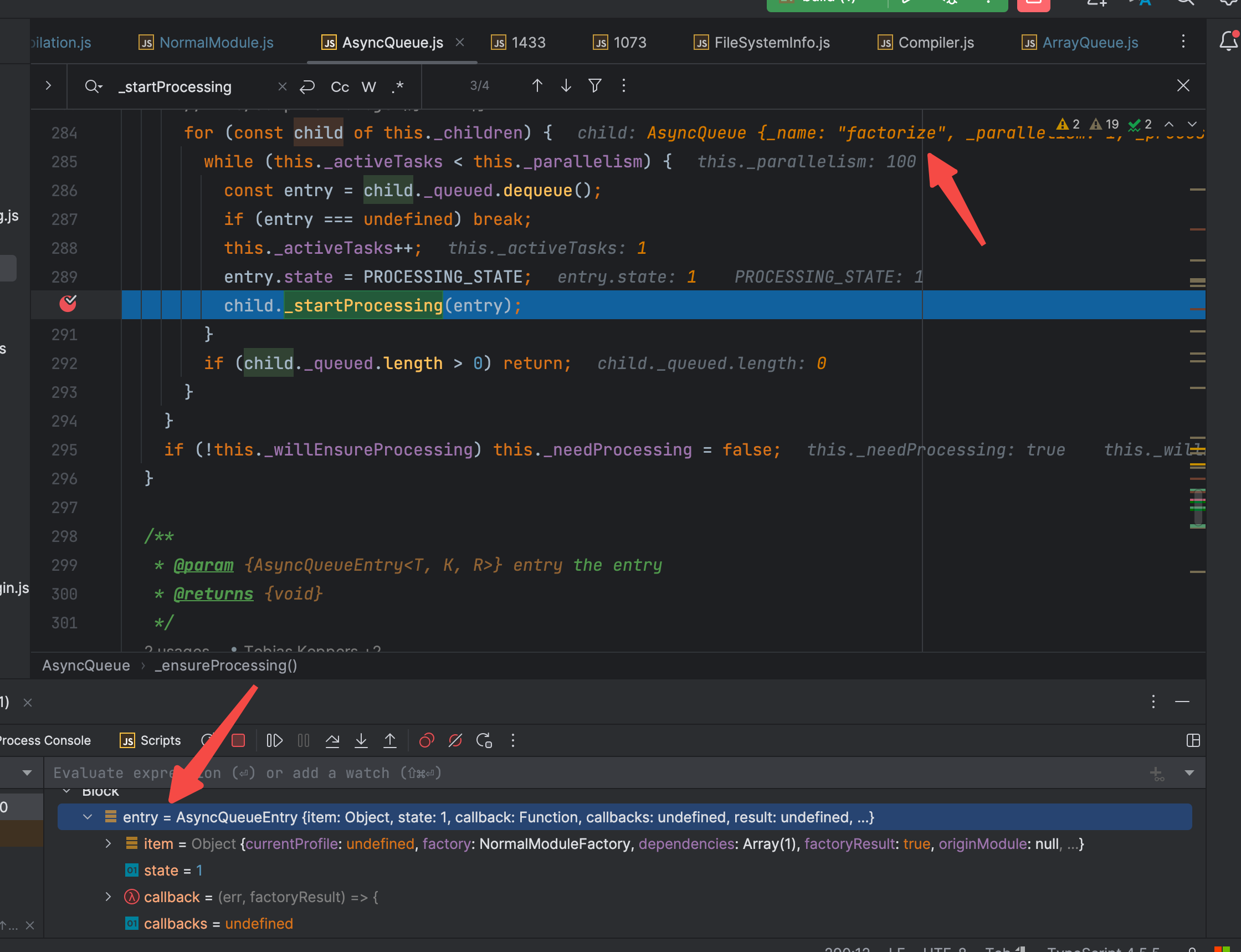
下一步应该是进入factorize 队列的_startProcessing 方法了(注意队列已经切换了)。继续 debug,
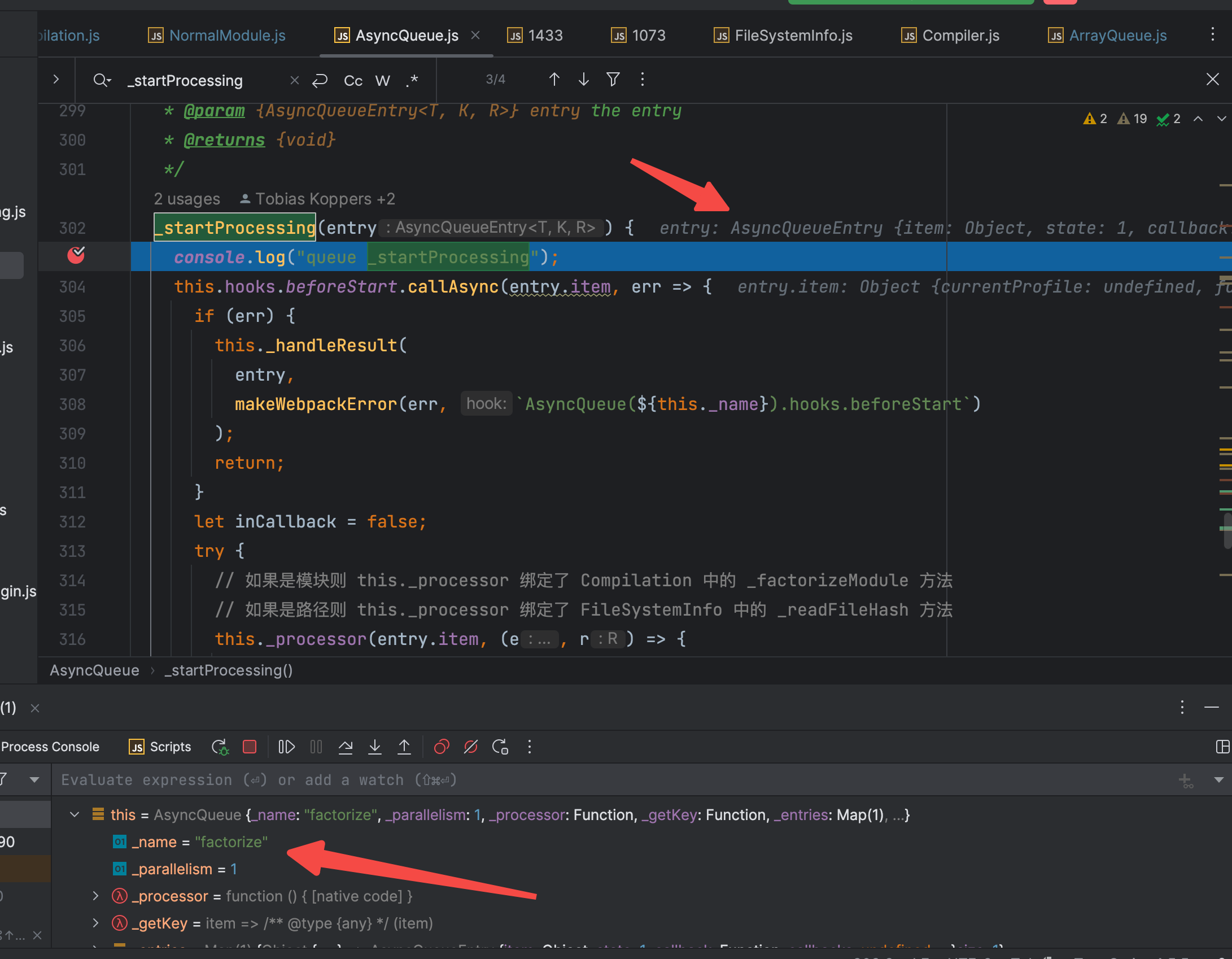
注意看,此时的 this 指向 是 factorize 队列。那就继续调试 _startProcessing 方法。
调试 this.hooks.beforeStart hook,结果如下: 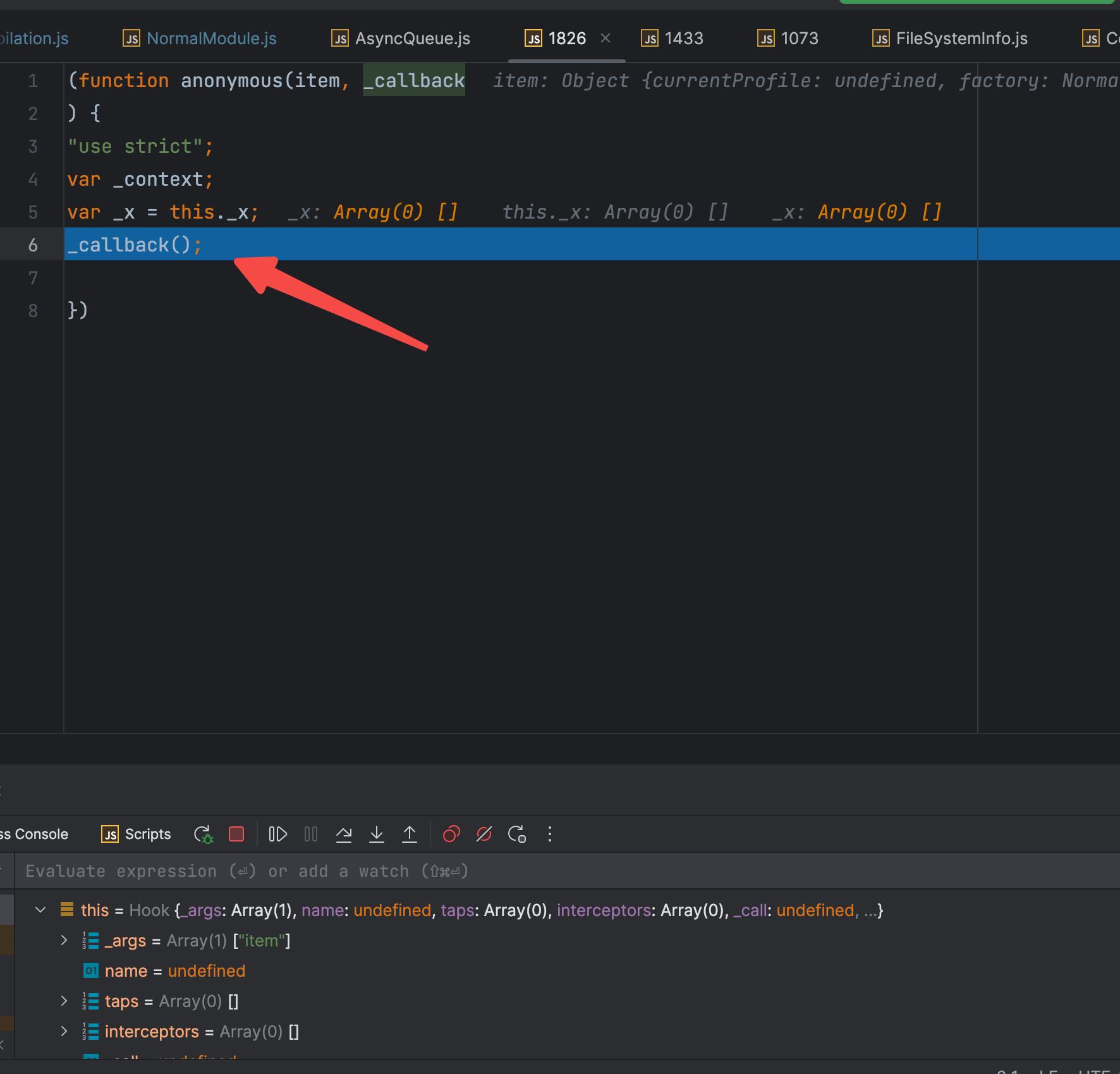 还是未绑定任何的插件,继续执行下去。
还是未绑定任何的插件,继续执行下去。
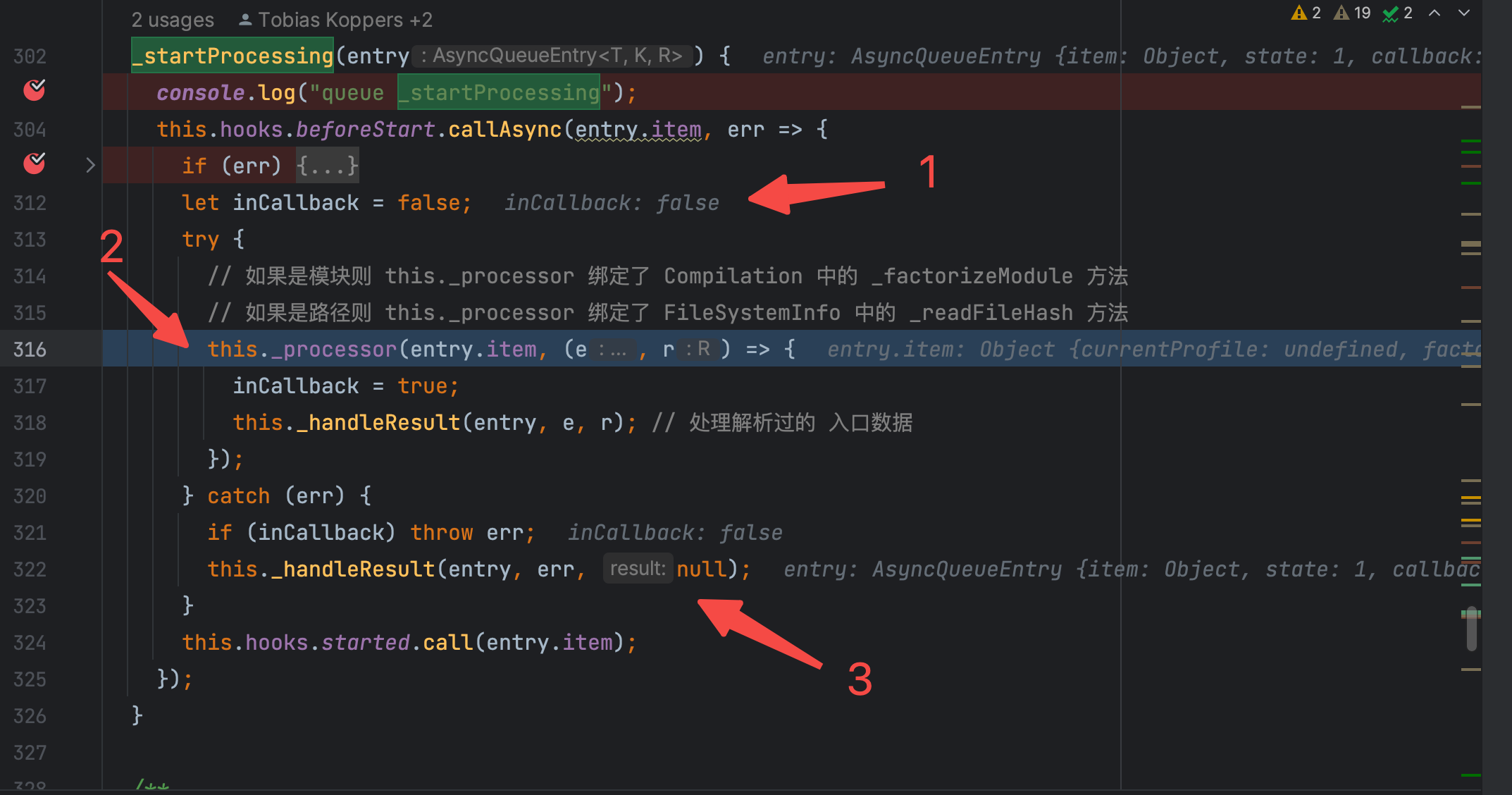
没有出现 err,直接忽略,开始看 316 行,此处的执行的 this._processor,让我们回顾一下 1.2章节 中的关于 constructor 的部分,核心代码如下图:
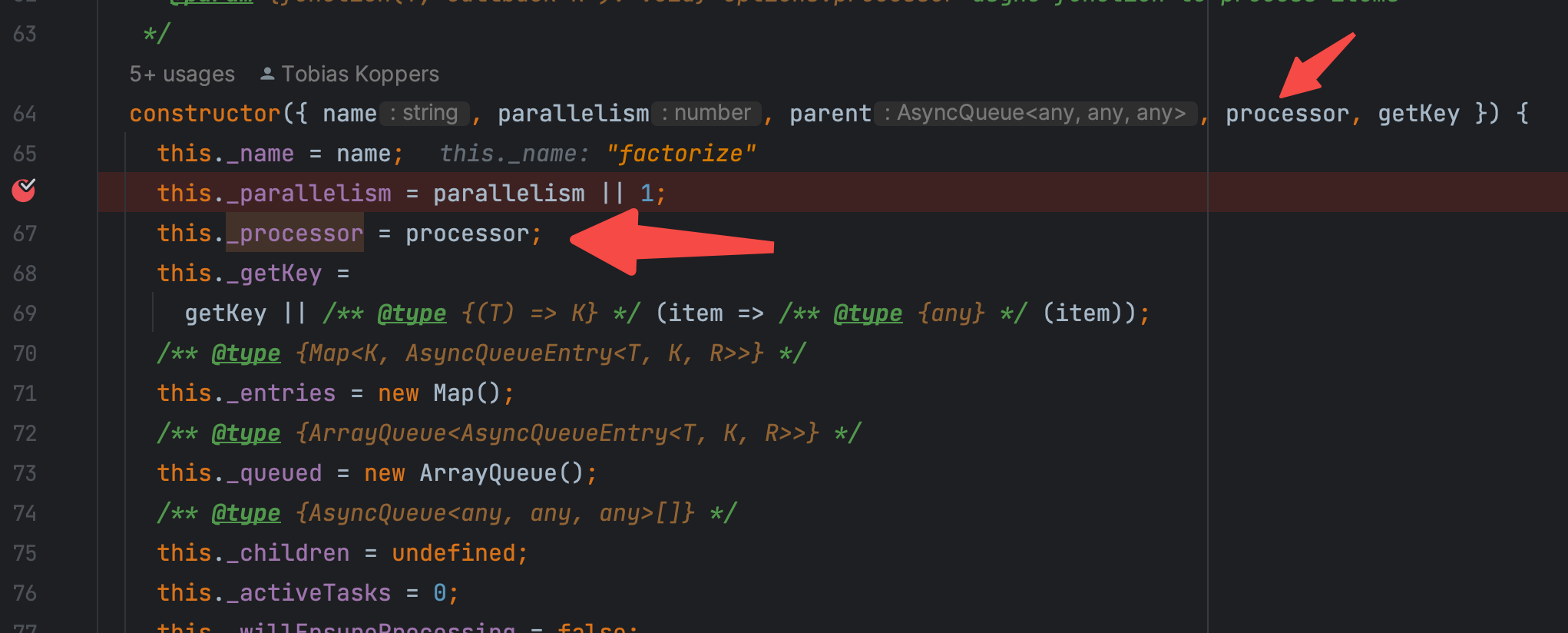
这意味着 我们要去看 实例化 factorize 时候传入的 processor 方法是什么?然后去执行它。 回顾 1.2章节 的代码
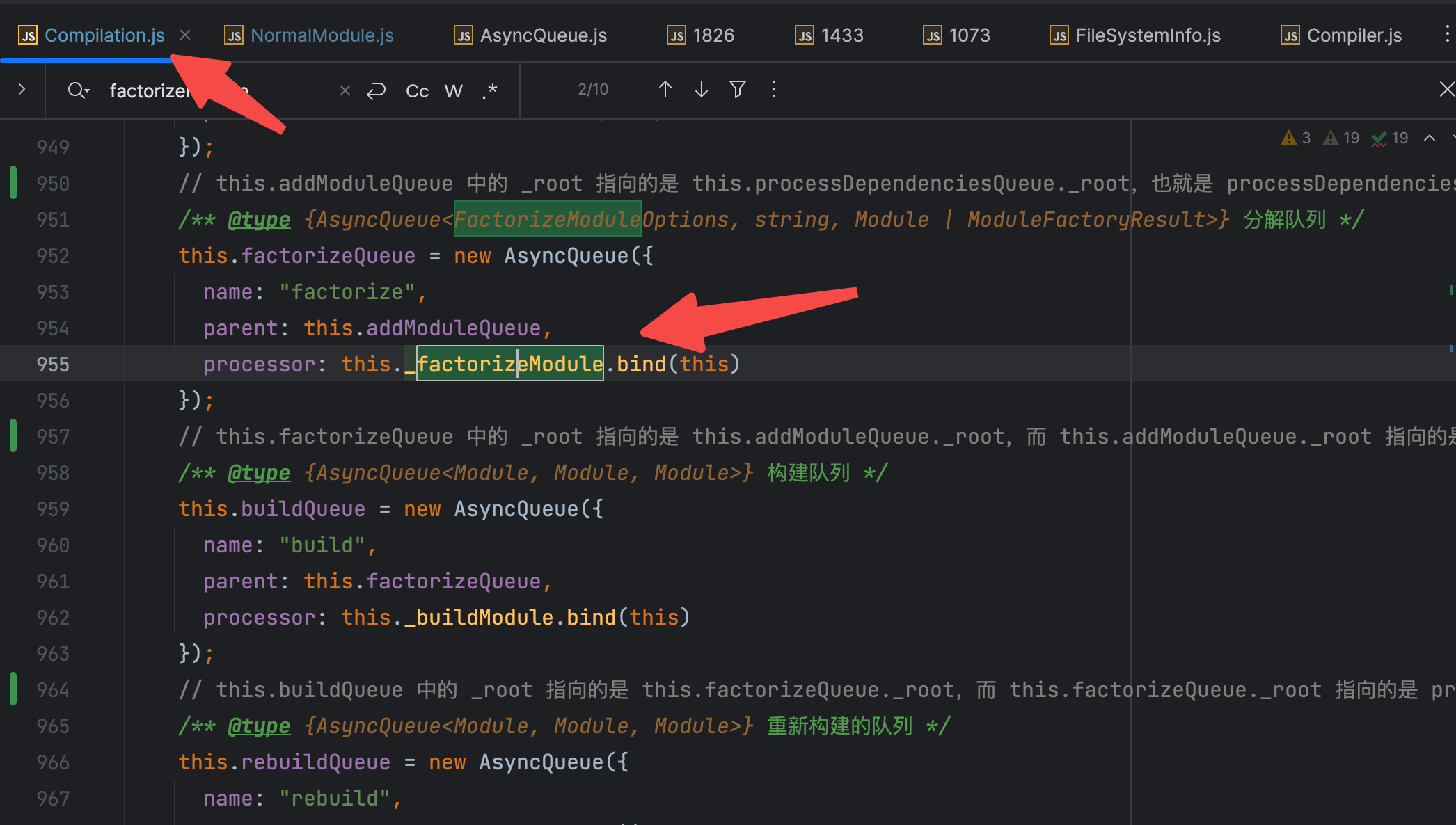
processor 指的是 compilation 中的 _factorizeModule 方法
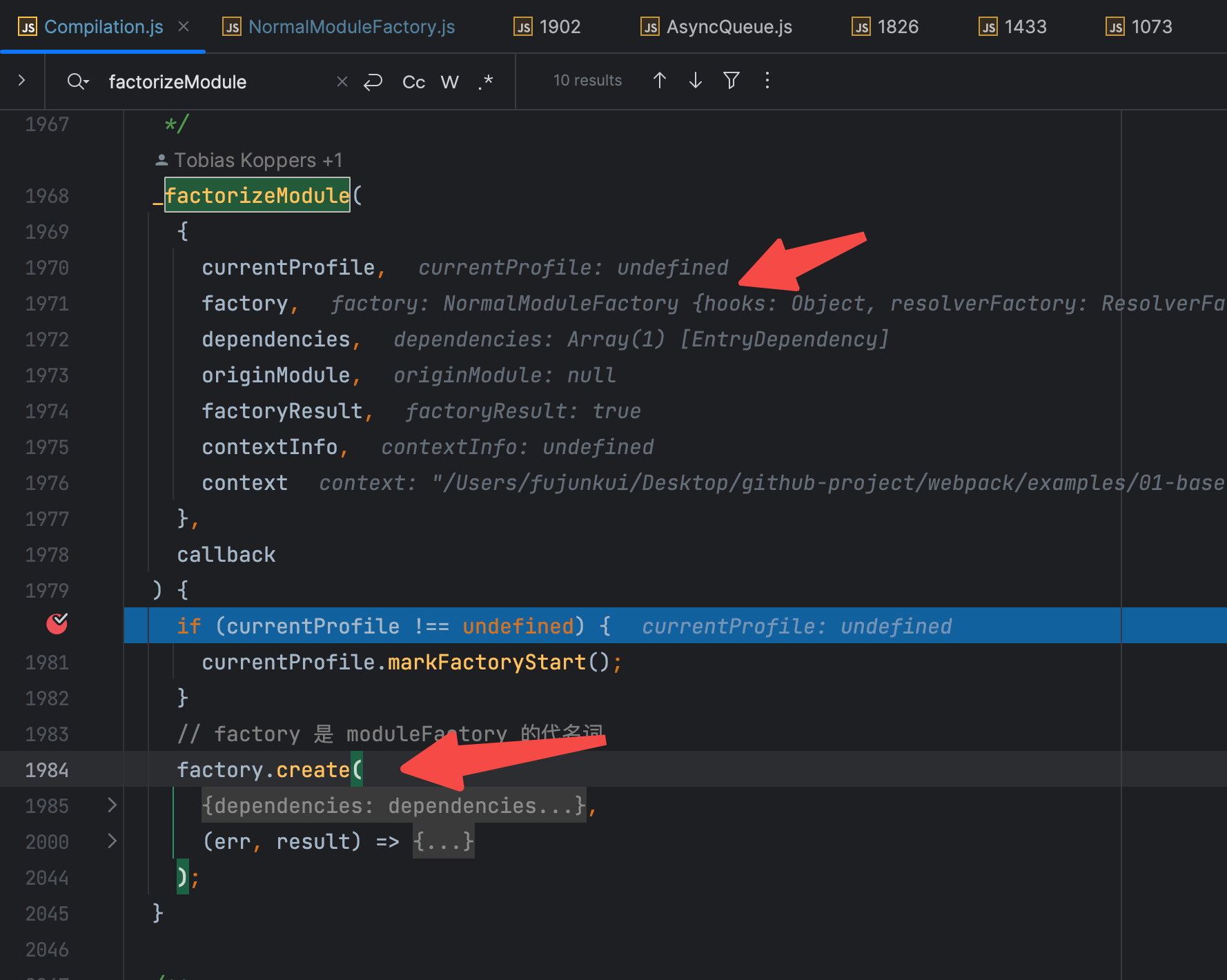
断点到 _factorizeModule 上,你会发现其主要执行的是 factory.create 方法,而此时的 factory 是 NormalModuleFactary 的实例,这里本质上也就是去 执行 NormalModuleFactary 类的 create 方法。
2.2 执行 NormalModuleFactary 类的 create 方法
断点进入该 create 函数,核心代码逻辑如下:
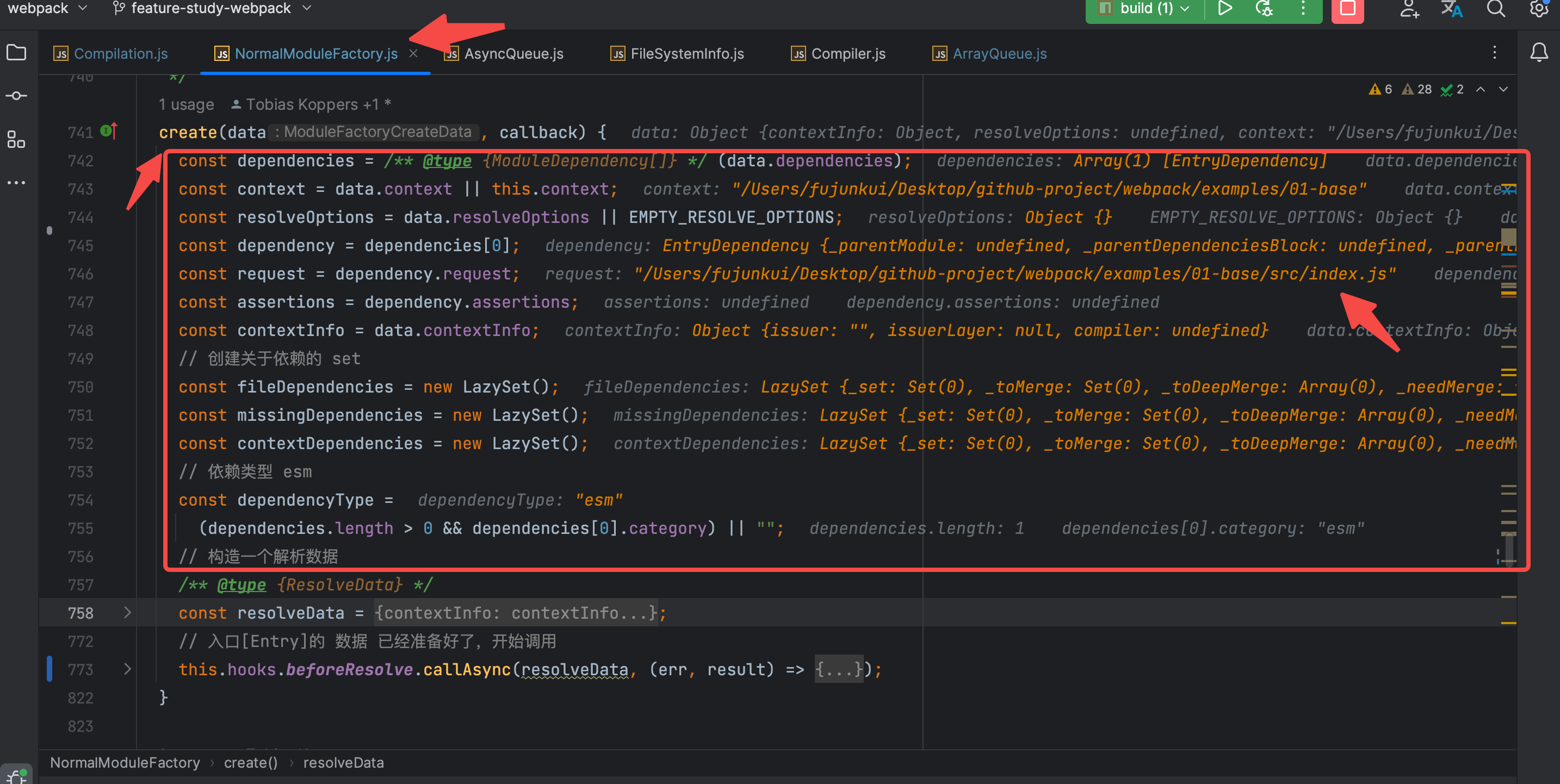
从742 到 755 行,很明显的都可以看出仅仅是变量的赋值和变量的初始化,而所有的变量都是存在了resolveData 对象里。走一下断点,看一下里面都是什么数据。
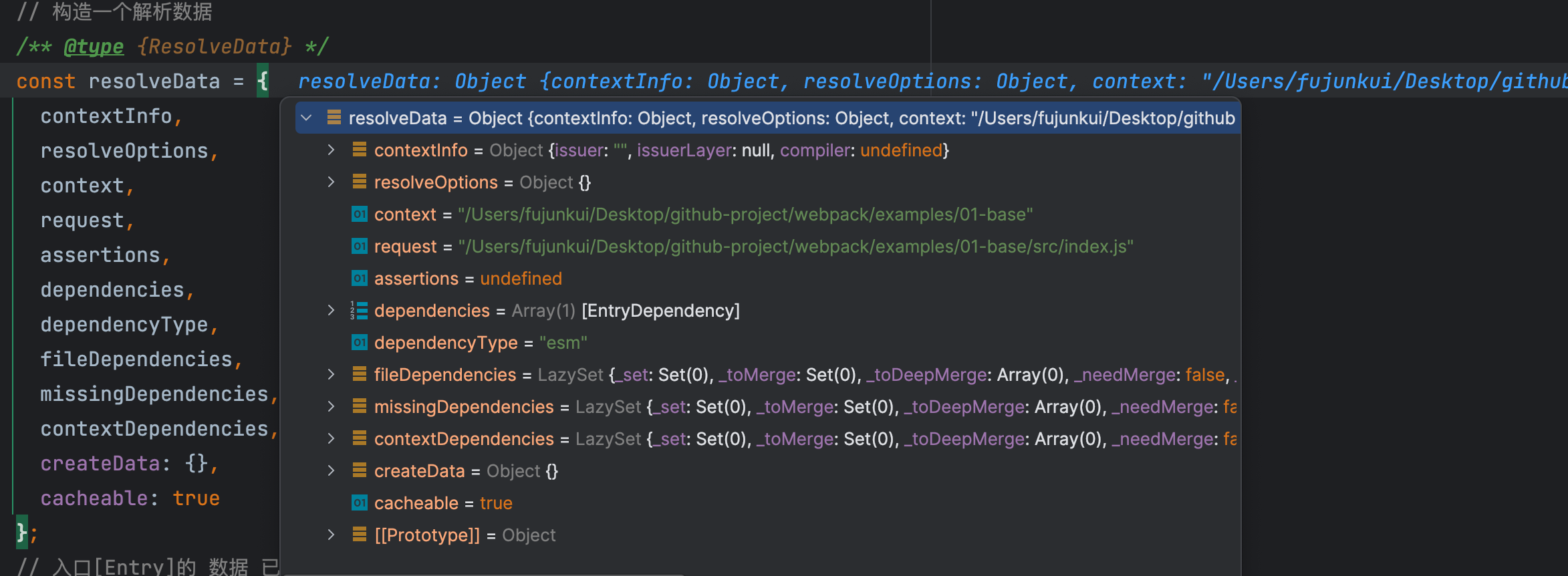
此处没啥难点,继续向下走,要进入beforeResolve的 hook 里了,直接断点进入,
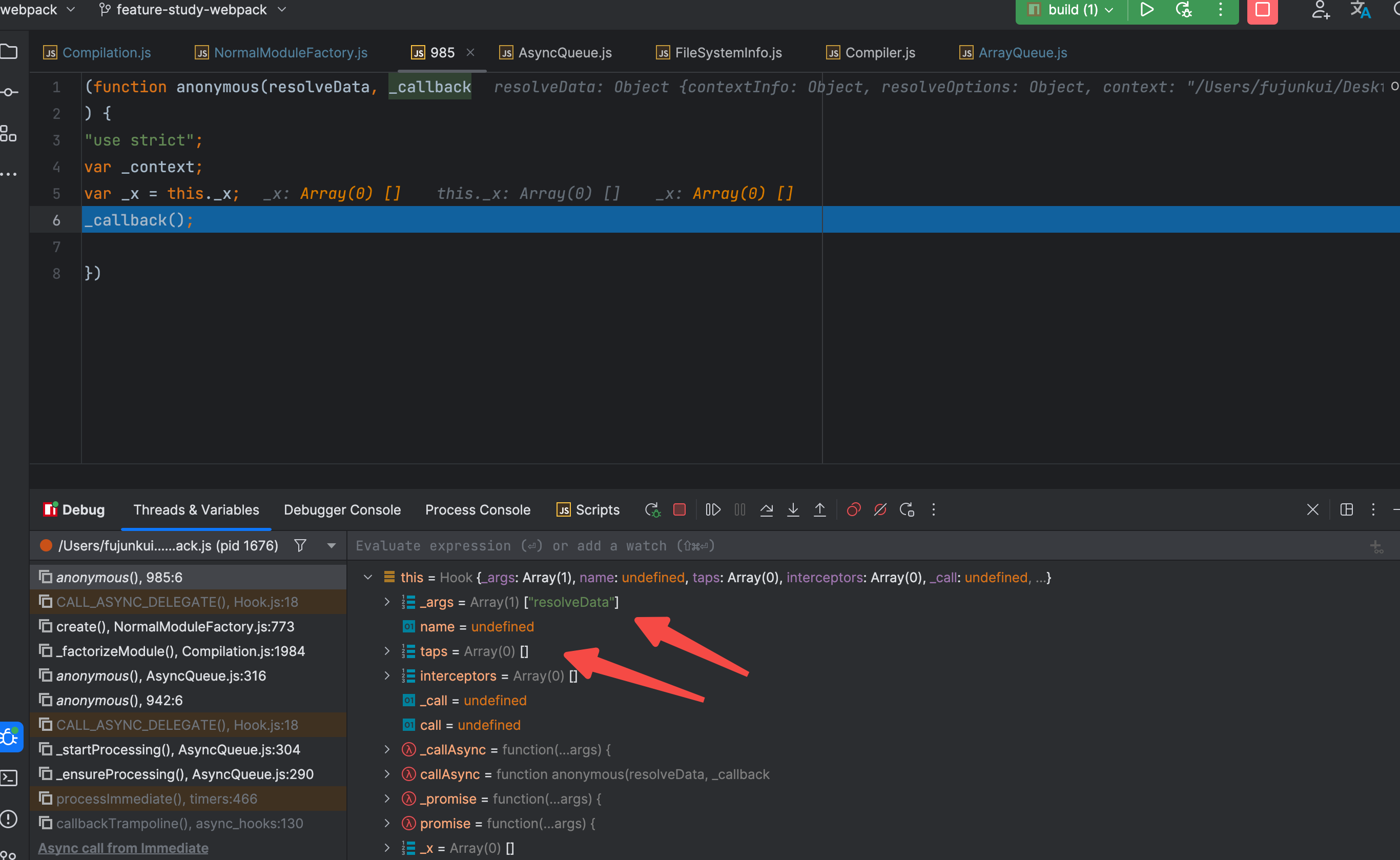 发现此 hook 也没有被任何插件所监听,那就直接进入此 hook 的 callback 里。
发现此 hook 也没有被任何插件所监听,那就直接进入此 hook 的 callback 里。
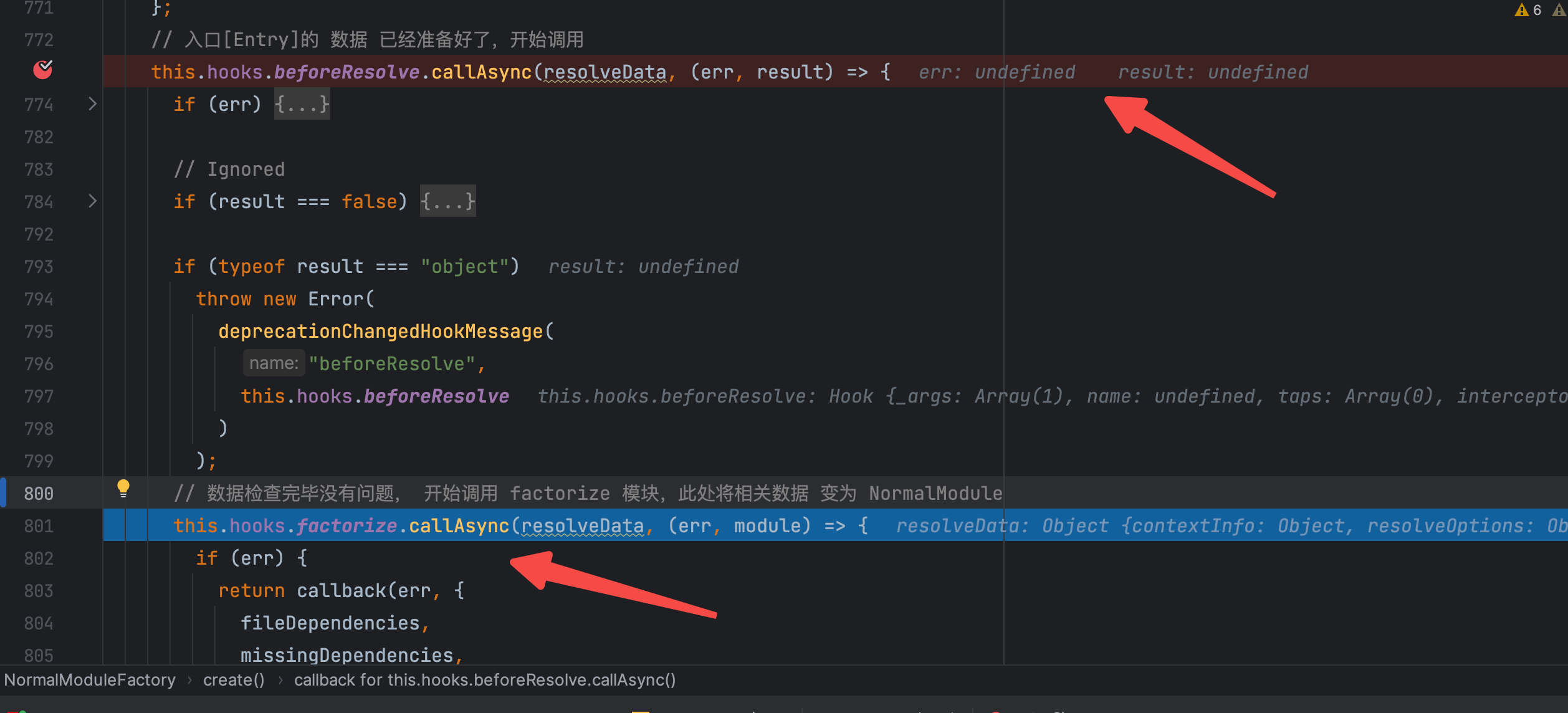
err 和 result 变量都是undefined,毫无疑问的又进入到了 801 行的 factorize 的 hook 了,那就继续断(慢慢的就会明白 webpack5 插件强大的背后,是难读的设计和调试)。开始调试 NormalModuleFactary 的 factorize 的 hook。
2.3 调试 NormalModuleFactary 的 factorize 的 hook
老规矩,首先查看监听此 hook 的插件有哪些,见下图
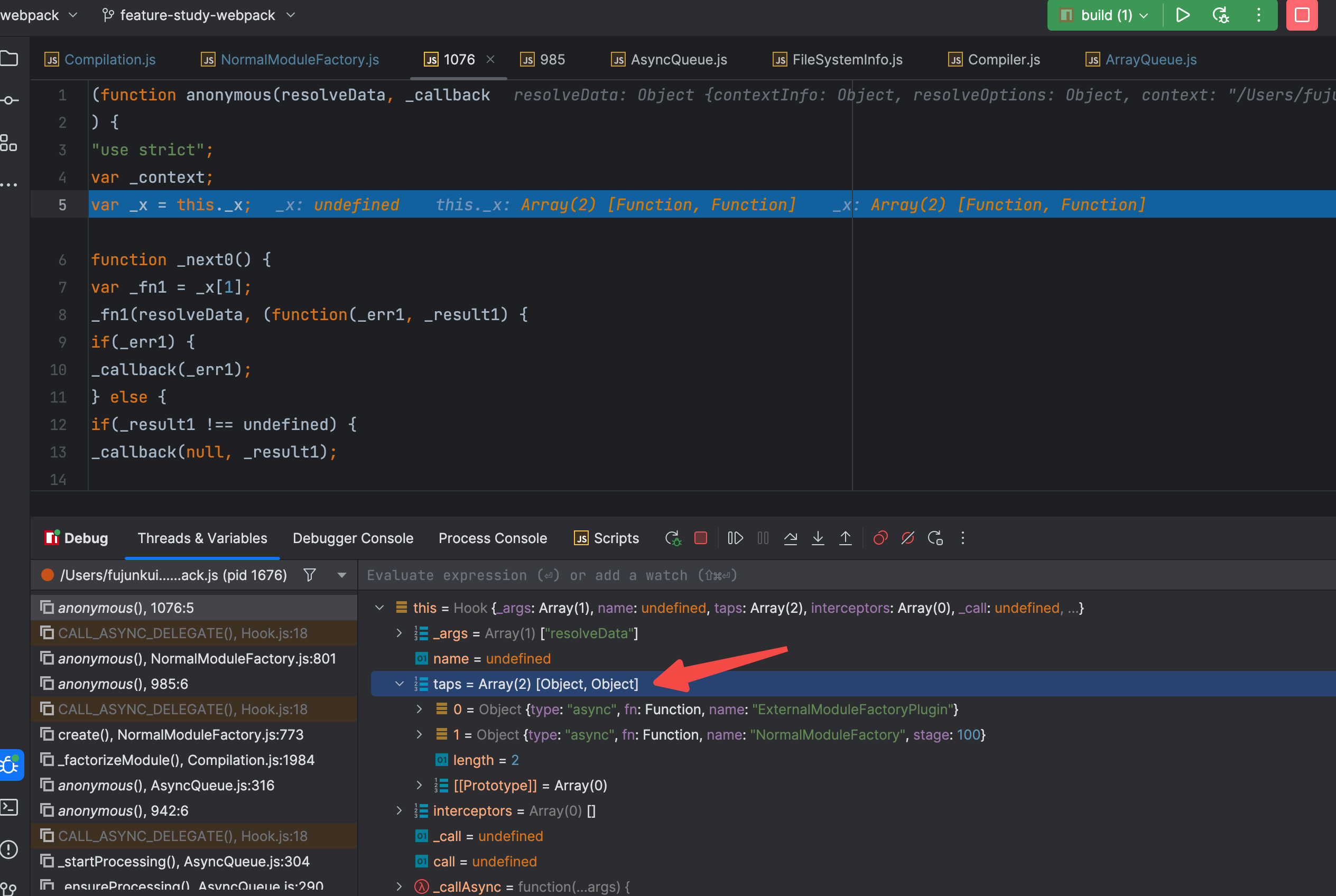
终于有插件进行监听了(注意此处NormalModuleFactory插件的stage属性),说明这个 hook 还是蛮重要的。继续断点,进入ExternalModuleFactoryPlugin的内部。
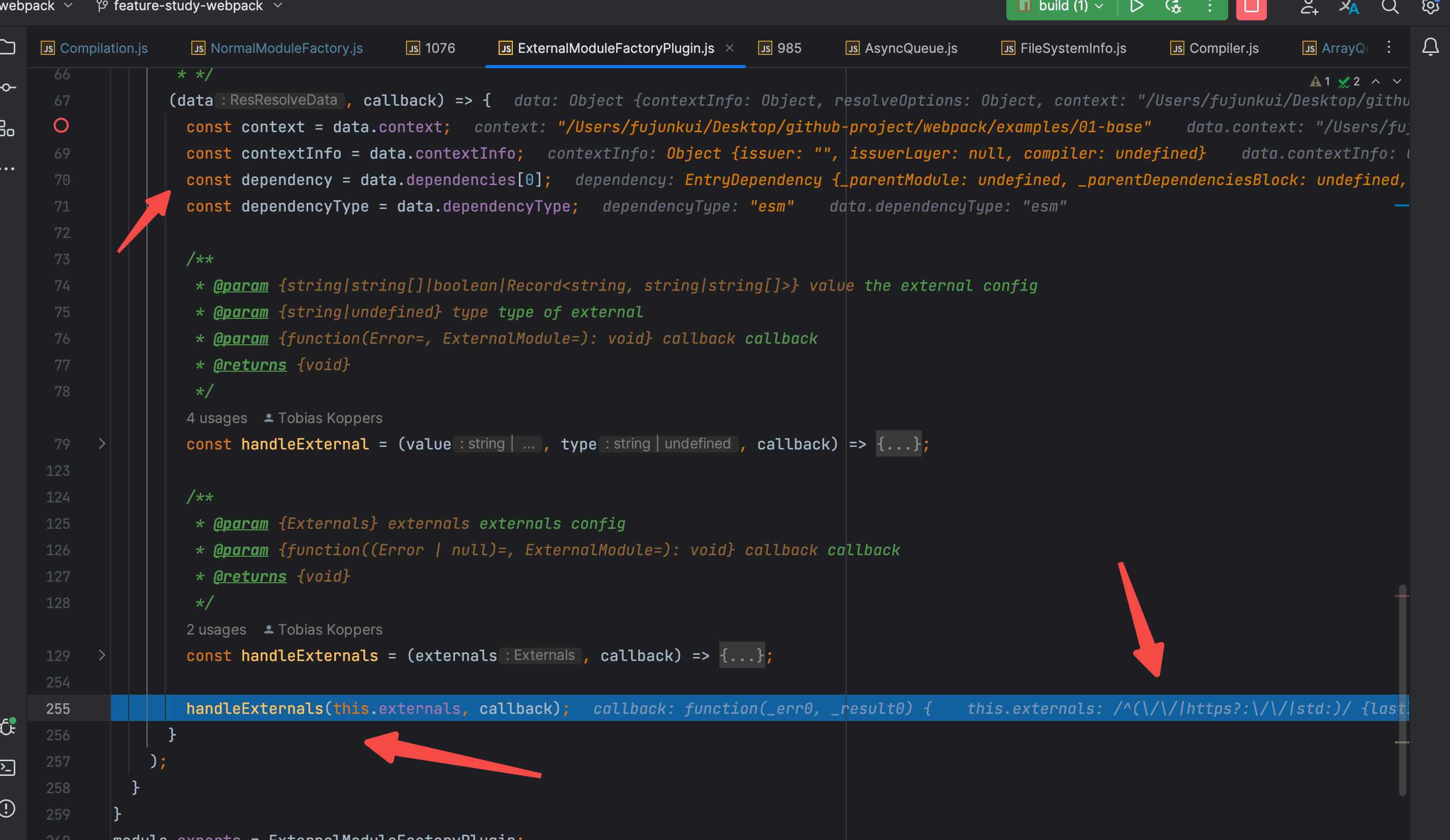
发现此插件的逻辑分为两部分,第一部队是去一步一步解构赋值传入的 resolveData 的数据。(不明白此处作者为啥不使用 es6 的对象解构语法去处理。。。。),然后生命两个函数,最后调用handleExternals 函数,传入 ExternalModuleFactoryPlugin插件 实例的 externals 属性,注意看此处的 externals 属性是 /^(\/\/|https?:\/\/|std:)/ (这个正则表达式用于匹配字符串的开头是否以”//“或”http://“或”https://“或”std:“)。
ExternalModuleFactoryPlugin 是 Webpack 的内置插件之一,它的作用是帮助 Webpack 处理外部的模块引入。在使用 Webpack 打包时,如果一个模块需要从外部引入,可以通过设置 externals 属性实现。ExternalModuleFactoryPlugin 插件会通过检查这些外部模块的配置,生成对应的 ExternalModule 对象,在 Webpack 运行过程中当这些模块被请求时,ExternalModuleFactoryPlugin 会负责处理这个请求。
进入handleExternals 函数里,结果如下图:
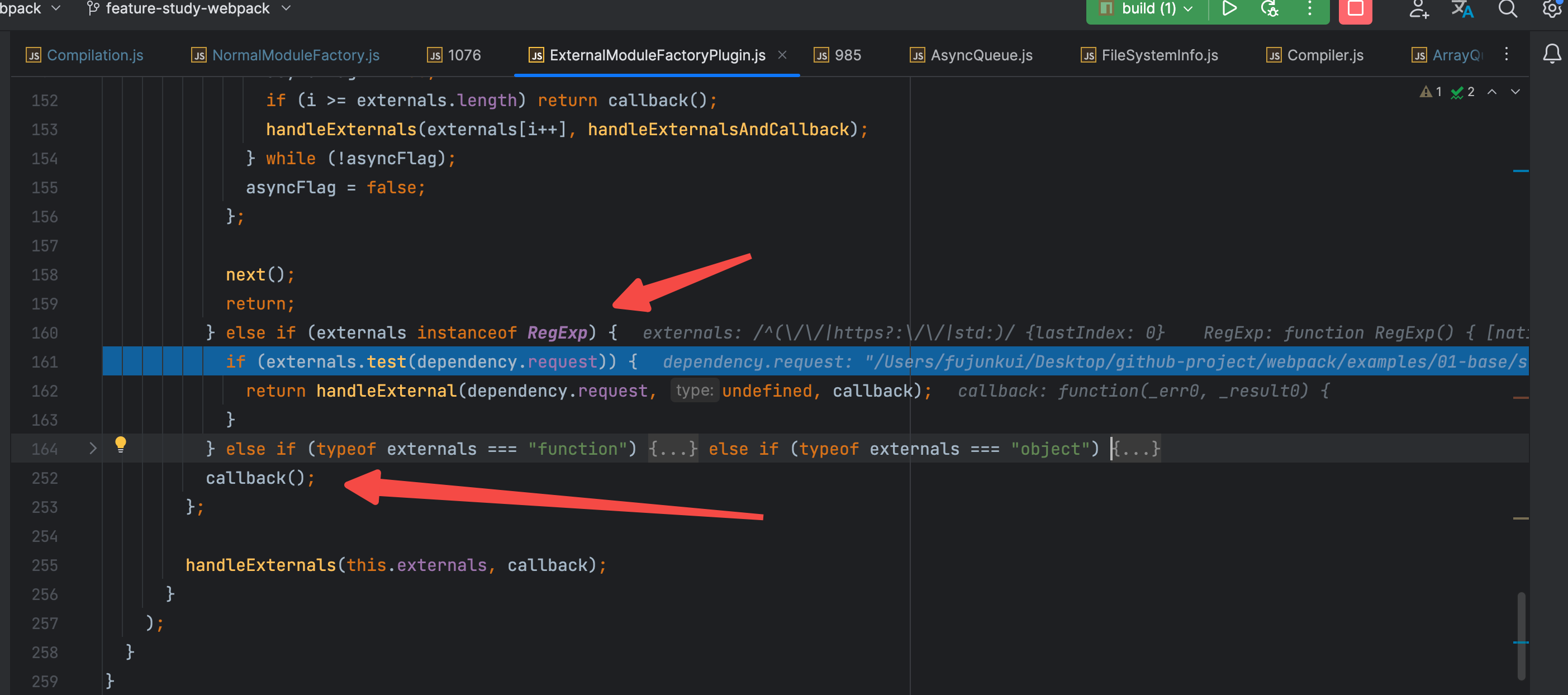 由于我们的本次的依赖是本地依赖,所以正则匹配失败了,那么结果就是要走到
由于我们的本次的依赖是本地依赖,所以正则匹配失败了,那么结果就是要走到 callback 里了。转了一圈啥也没有做,callback 为空,那就继续断点,向下执行,进入 NormalModuleFactory 插件里。
2.4 进入 NormalModuleFactory 插件执行factorize 的 hook 【核心逻辑】
断点进入:
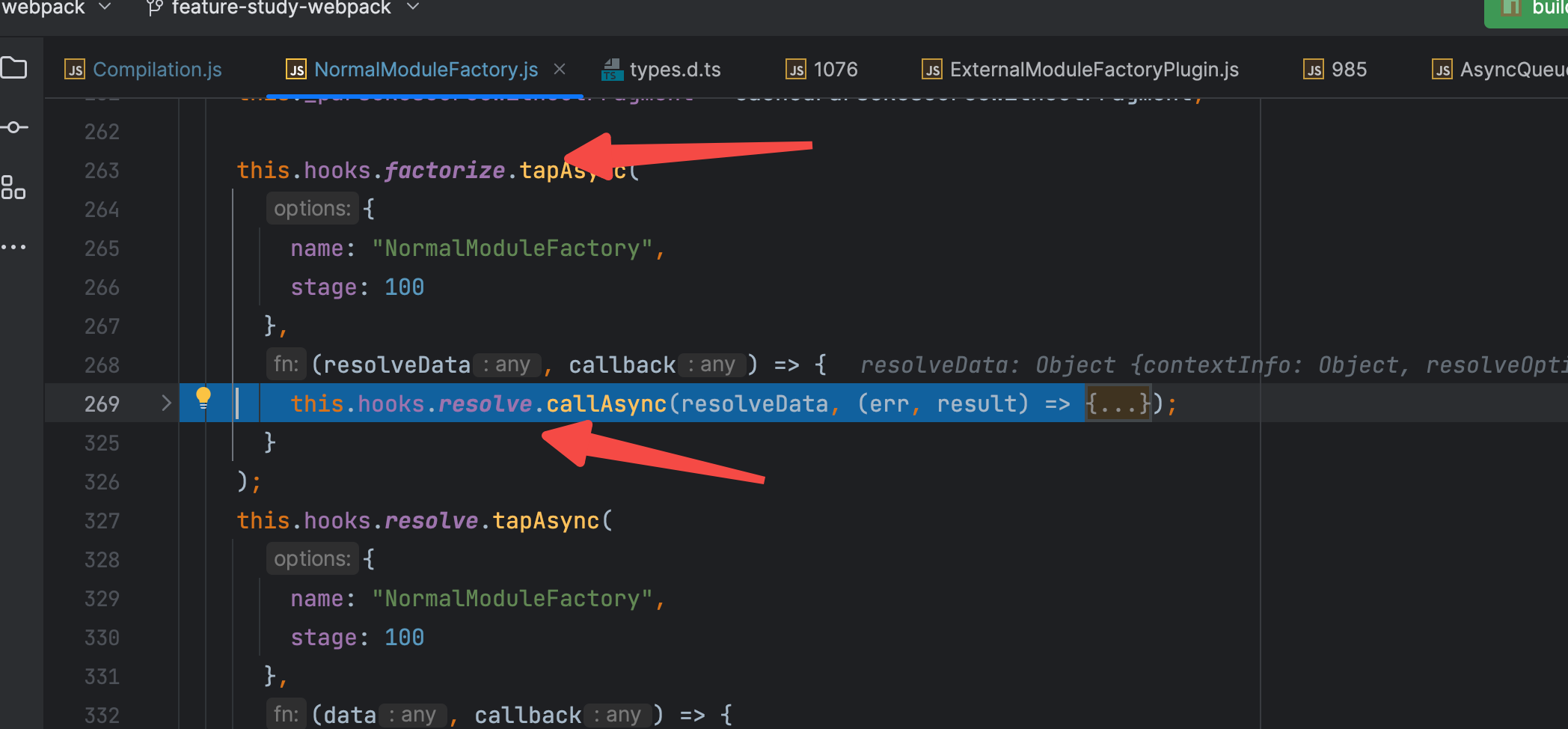 进入以后你会发现,这个 hook 又触发了
进入以后你会发现,这个 hook 又触发了 resolve 的 hook,这不就是套娃吗?然后继续断点看监听了resolve的 hook 上都有哪些插件?
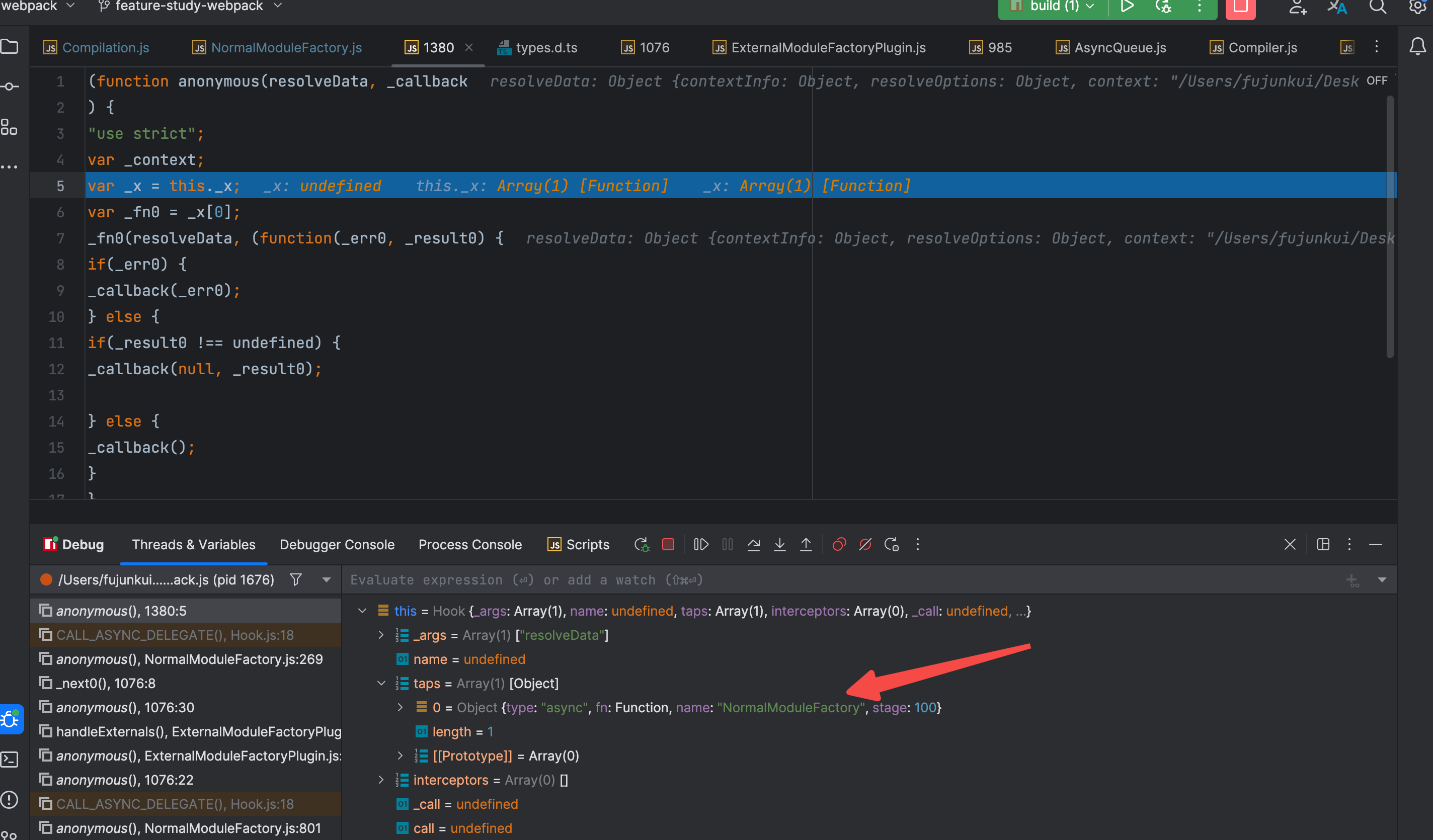 你会发现监听此 hook 的还是这哥们自身,这不是耍我们呢吗????? 实则不然,他完全可以写的很优雅,但是为了能尽可能的把 hook 给暴露出去,增强 webpack 的定制化能力,不得不这么做。
你会发现监听此 hook 的还是这哥们自身,这不是耍我们呢吗????? 实则不然,他完全可以写的很优雅,但是为了能尽可能的把 hook 给暴露出去,增强 webpack 的定制化能力,不得不这么做。
如果是你,易读和强大的能力你会选择哪个呢?
继续断点下去。
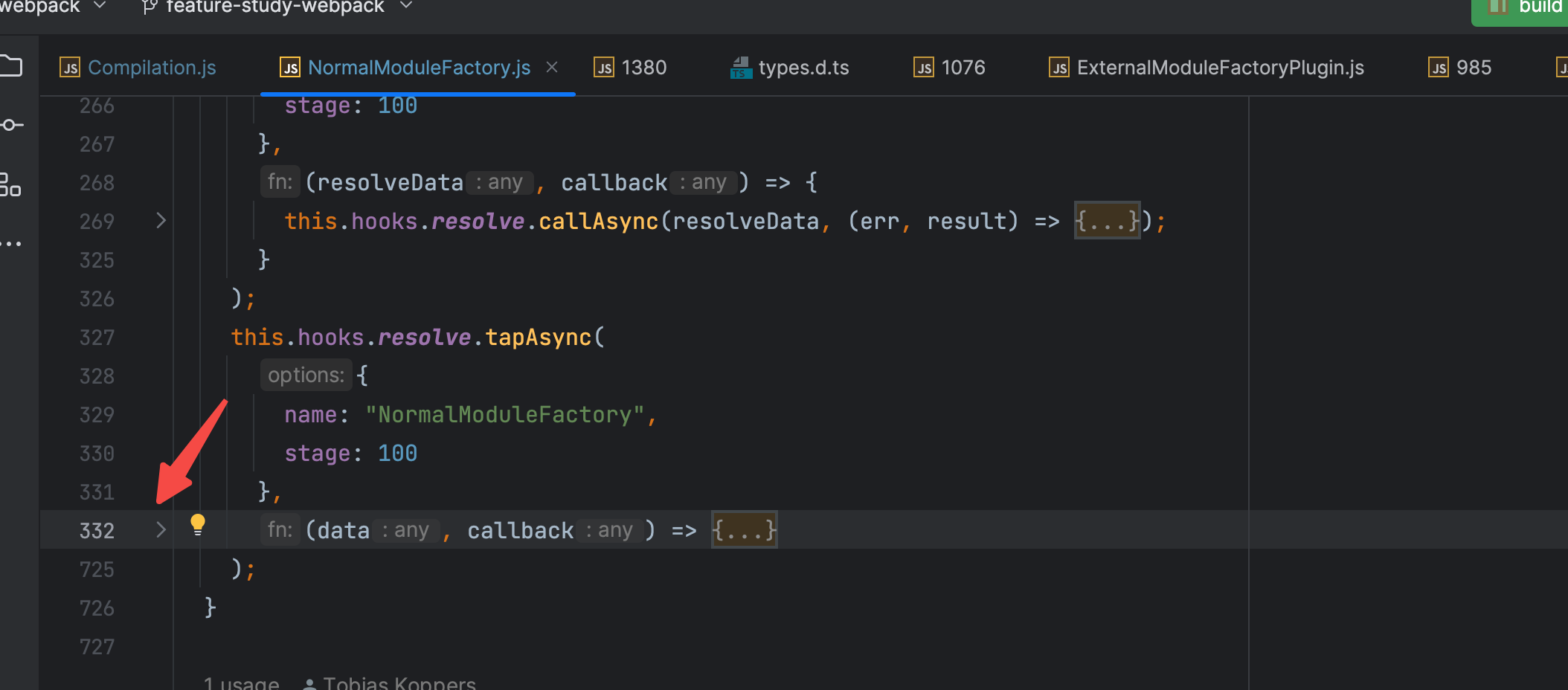 你会发现此 hook 的逻辑竟然高达 400 行左右的代码,一起去断点看看做了什么吧,我会把某些当前无用的方法过滤掉。
你会发现此 hook 的逻辑竟然高达 400 行左右的代码,一起去断点看看做了什么吧,我会把某些当前无用的方法过滤掉。
const {
contextInfo,
context, // 上下文:/Users/fujunkui/Desktop/github-project/webpack/examples/01-base
dependencies,
dependencyType,
request, // 路径是:/Users/fujunkui/Desktop/github-project/webpack/examples/01-base/src/index.js
assertions,
resolveOptions,
fileDependencies,
missingDependencies,
contextDependencies,
} = data
const contextScheme = getScheme(context) // undefined
let scheme = getScheme(request) // undefined
if (!scheme) {
const requestWithoutMatchResource = request
scheme = getScheme(requestWithoutMatchResource)
if (!scheme && !contextScheme) {
const firstChar = requestWithoutMatchResource.charCodeAt(0)
const secondChar = requestWithoutMatchResource.charCodeAt(1)
console.log('dependencies start with')
noPreAutoLoaders = firstChar === 45 && secondChar === 33 // startsWith "-!"
noAutoLoaders = noPreAutoLoaders || firstChar === 33 // startsWith "!"
noPrePostAutoLoaders = firstChar === 33 && secondChar === 33 // startsWith "!!";
const rawElements = requestWithoutMatchResource
.slice(
noPreAutoLoaders || noPrePostAutoLoaders
? 2
: noAutoLoaders
? 1
: 0,
)
.split(/!+/)
unresolvedResource = rawElements.pop()
elements = rawElements.map((el) => {
const { path, query } = cachedParseResourceWithoutFragment(el)
return {
loader: path,
options: query ? query.slice(1) : undefined,
}
})
scheme = getScheme(unresolvedResource)
}
const continueCallback = () => {
// ....
}
this.resolveRequestArray(
contextInfo,
contextScheme ? this.context : context,
elements,
loaderResolver,
resolveContext,
(err, result) => {
if (err)
return continueCallback(err)
loaders = result
continueCallback()
},
)
if (scheme) {
// ...条件进不去
}
else if (contextScheme) {
// ...条件进不去
}
else { defaultResolve(context) }
}
部分核心代码的运行时的参数截图如下: 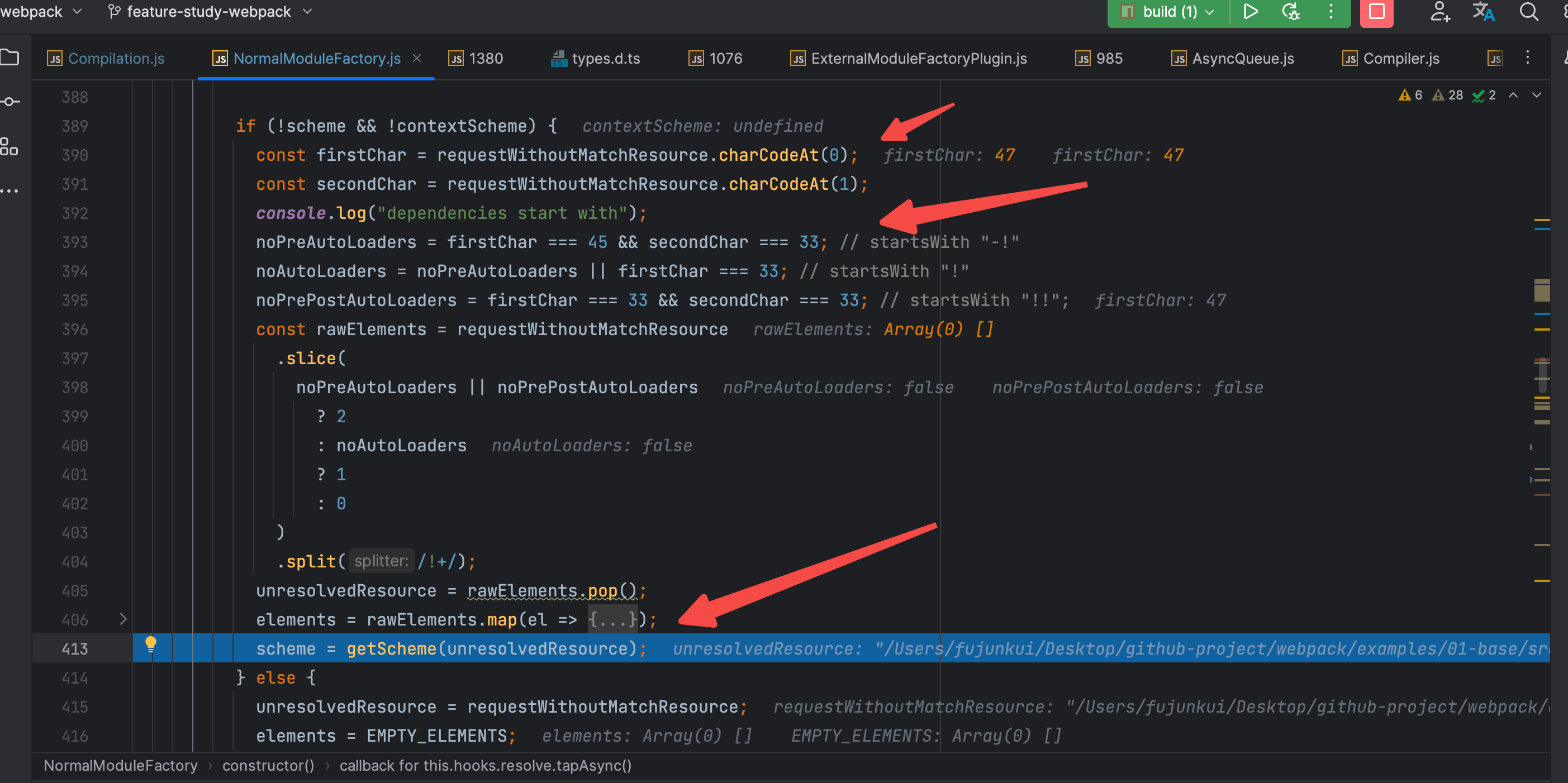 此处主要是判断 此文件的 request 路径是否以某些行内 loader 的方式进行开头的。 详情见官网
此处主要是判断 此文件的 request 路径是否以某些行内 loader 的方式进行开头的。 详情见官网
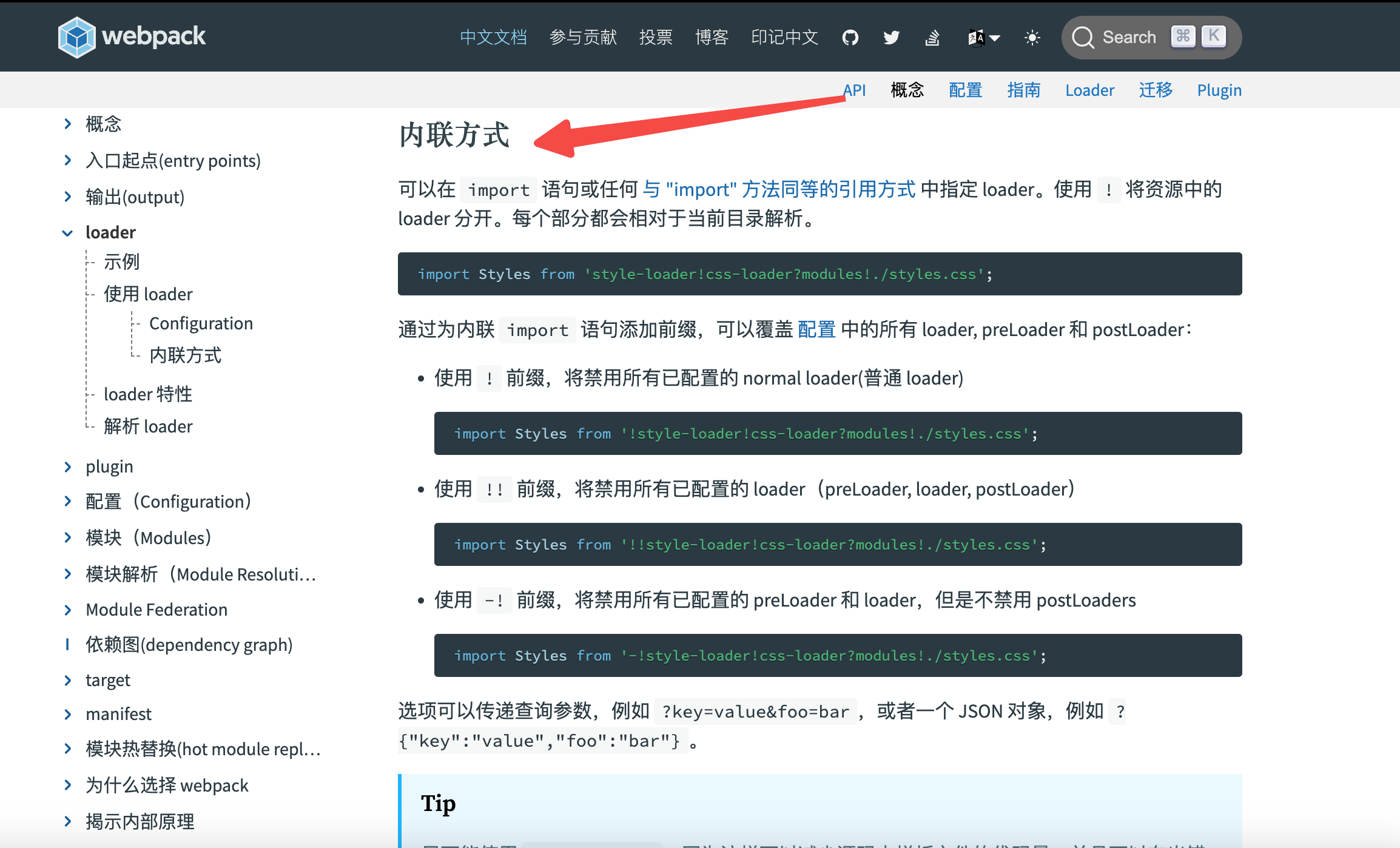
resolveRequestArray是必须要执行的,此处附上相关的运行结果
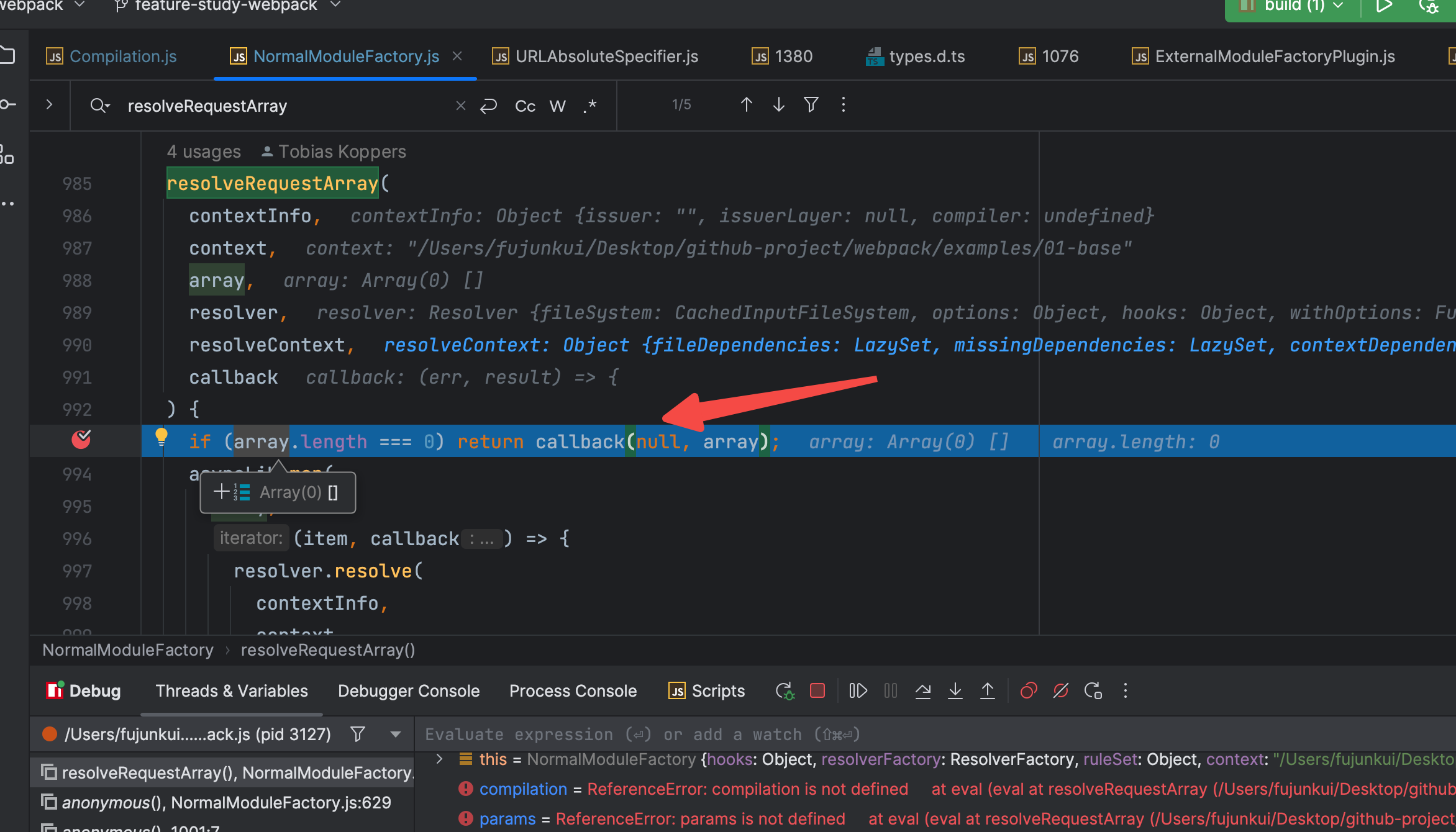
最后走进了 defaultResolve(context) 里。进入 此函数看执行过程。
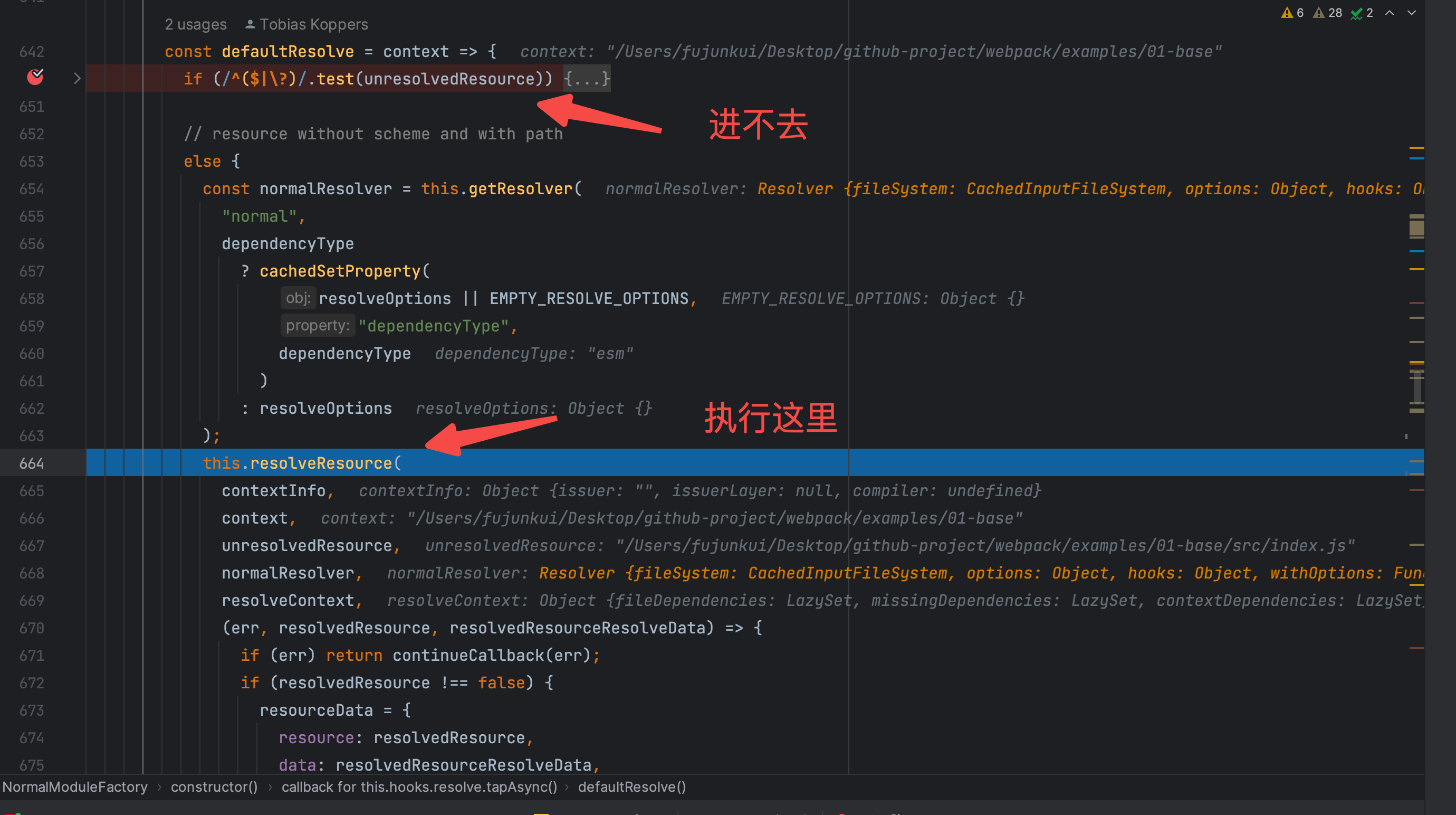
最后进入resolveResource函数里,断点进入。
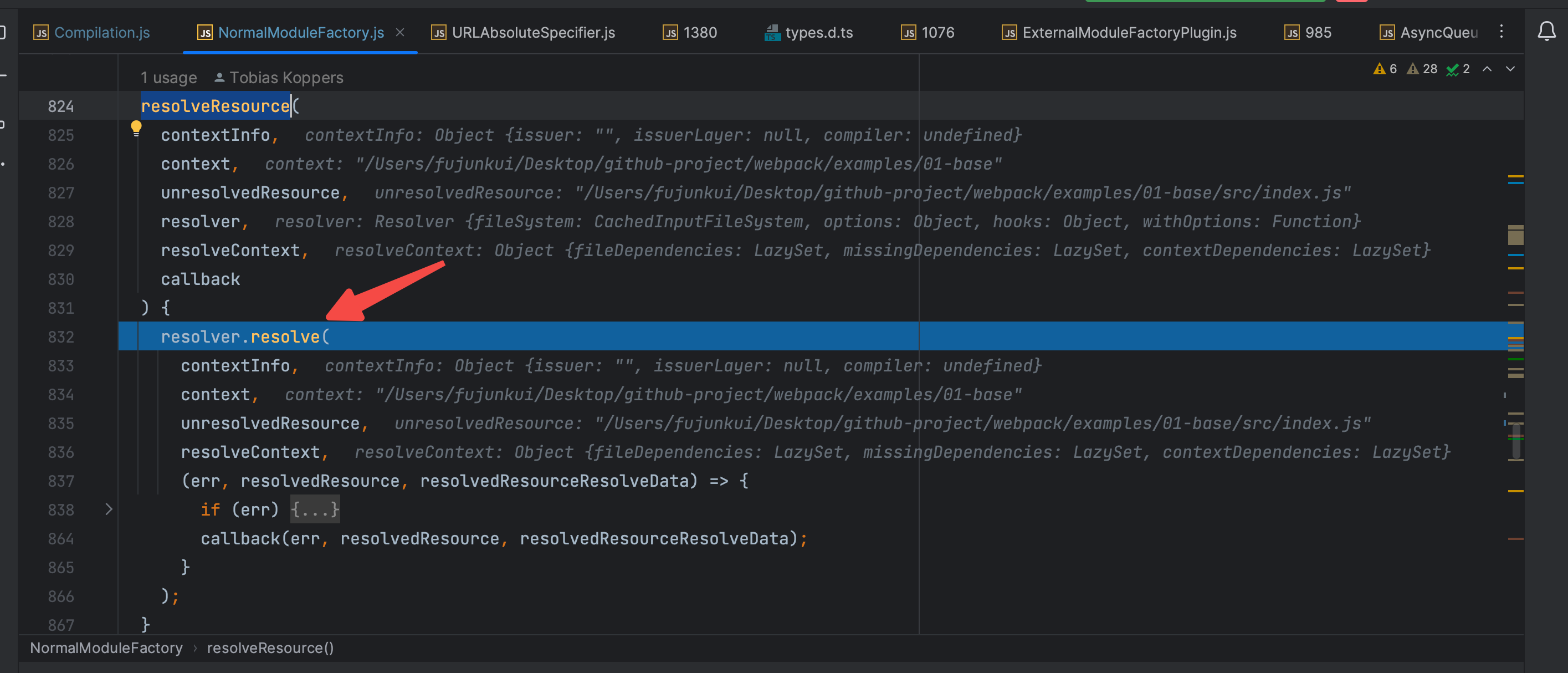
调用resolver.resolve的方法,获取到 unresolvedResource 的真实路径。
关于此处,如果你不了解
resolver.resolve的方法的原理,可以去看我前面的文章,【webpack核心库】耗时7个小时,用近50张图来学习enhance-resolve中的数据流动和插件调度机制,可以搜索一下上面的标题,也是干货满满。
继续断点,走到 callback 接受 resolve 处理以后的结果如下图。 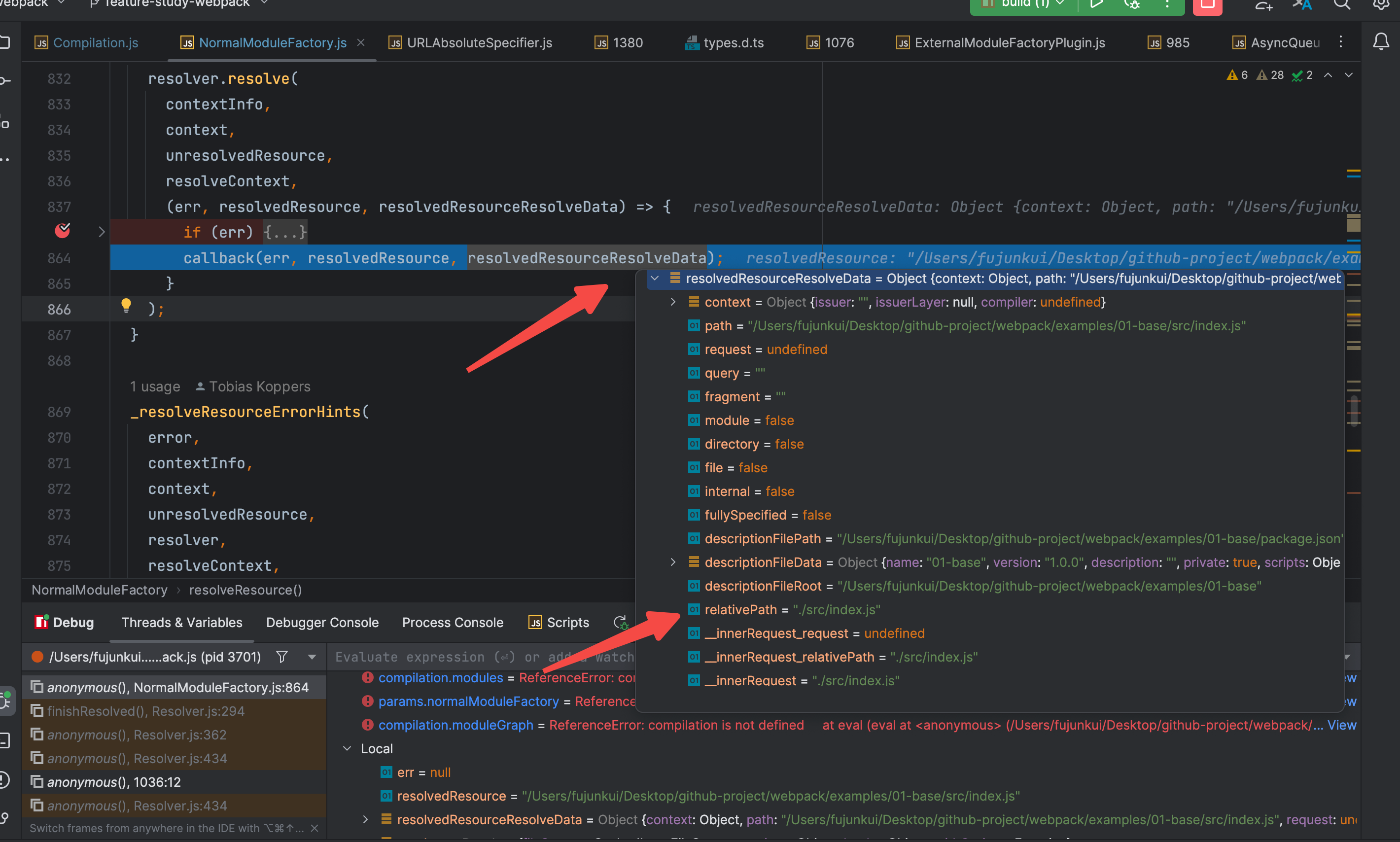
进入 callback 里。
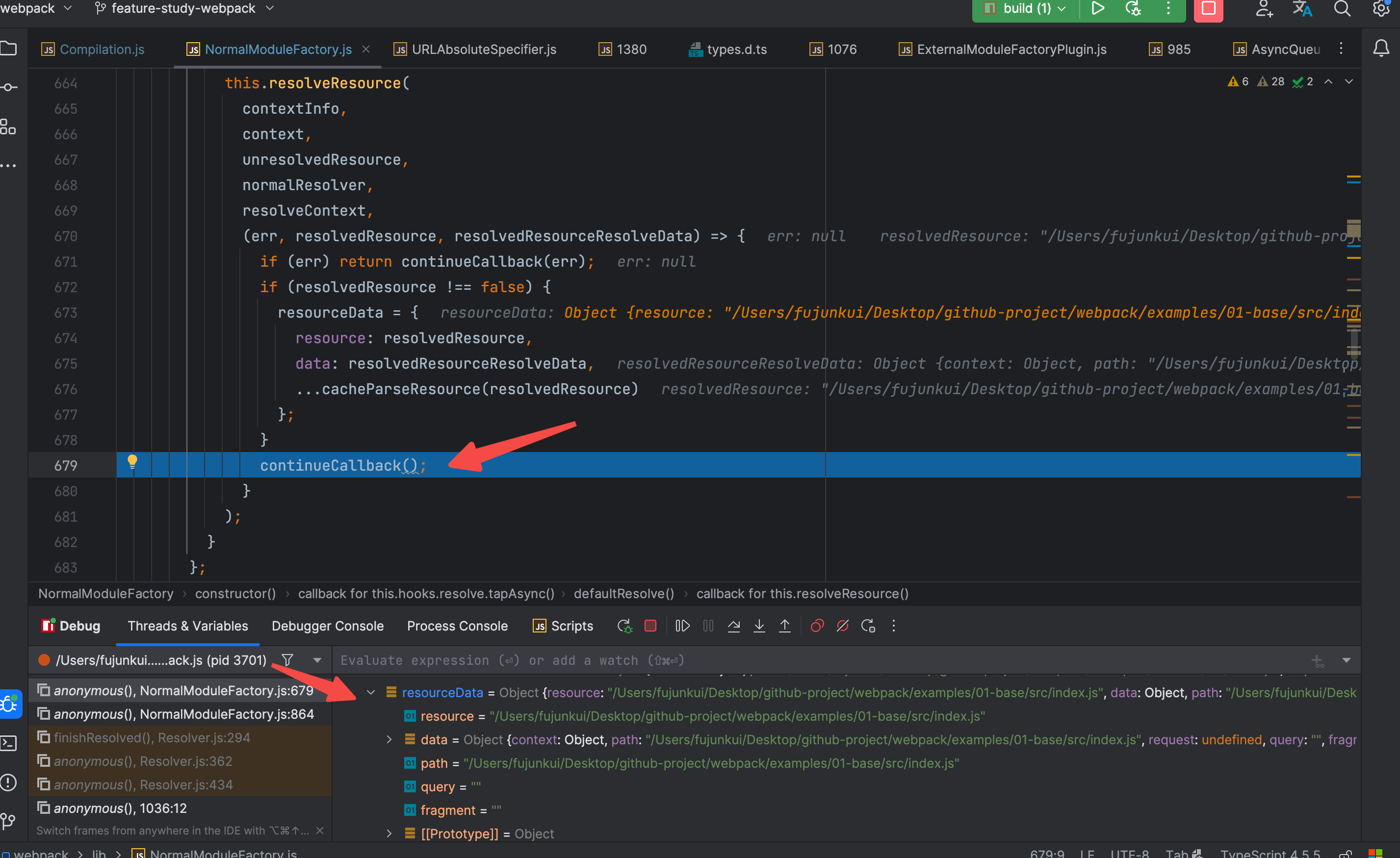
发现最后走到了 continueCallback 函数里。
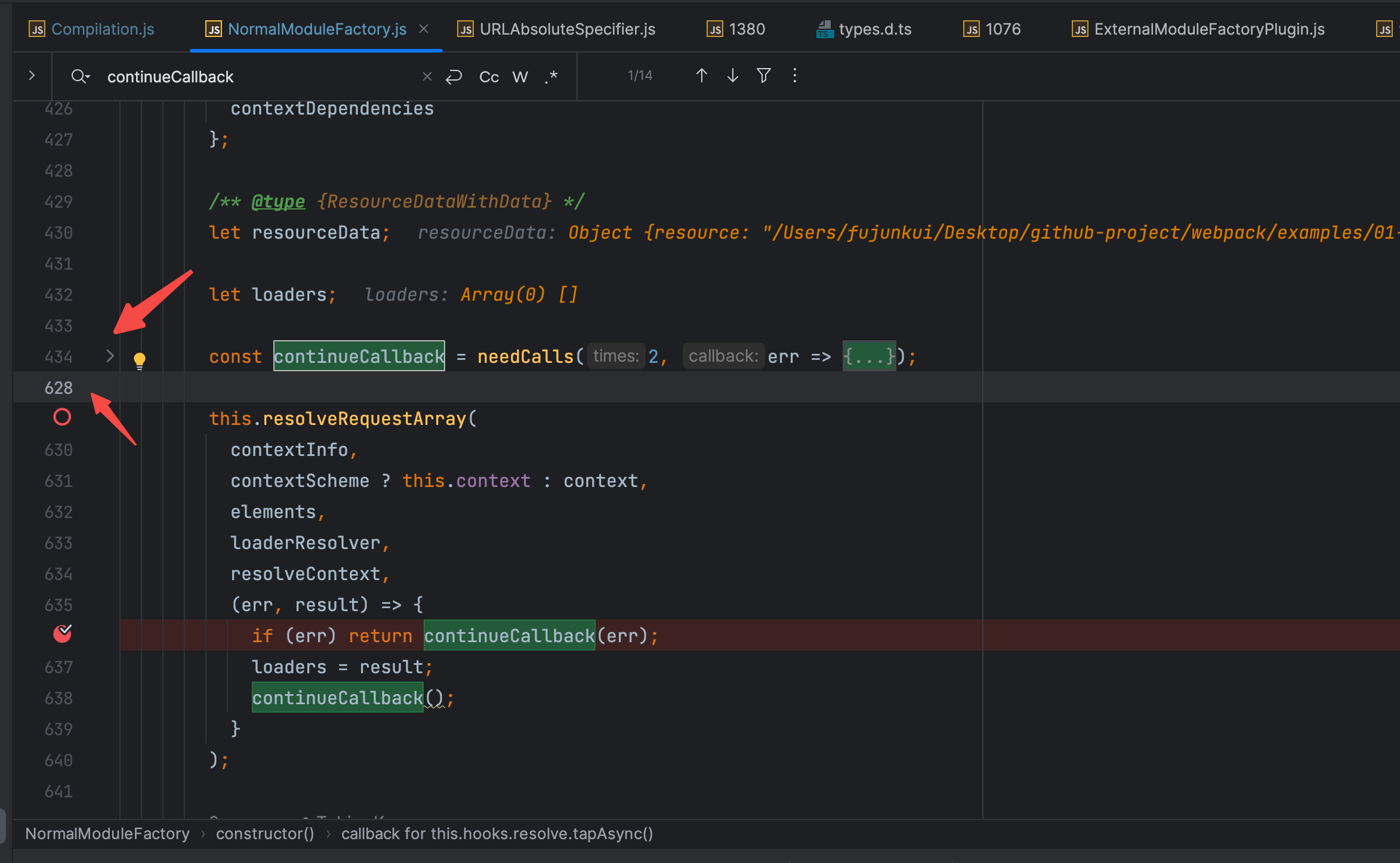
关于此函数,内容有些多,此处就不做进行解析了。直接断点回到刚刚的 this.hooks.resolve.callAsync的部分。在其 callback 内部打上断点。
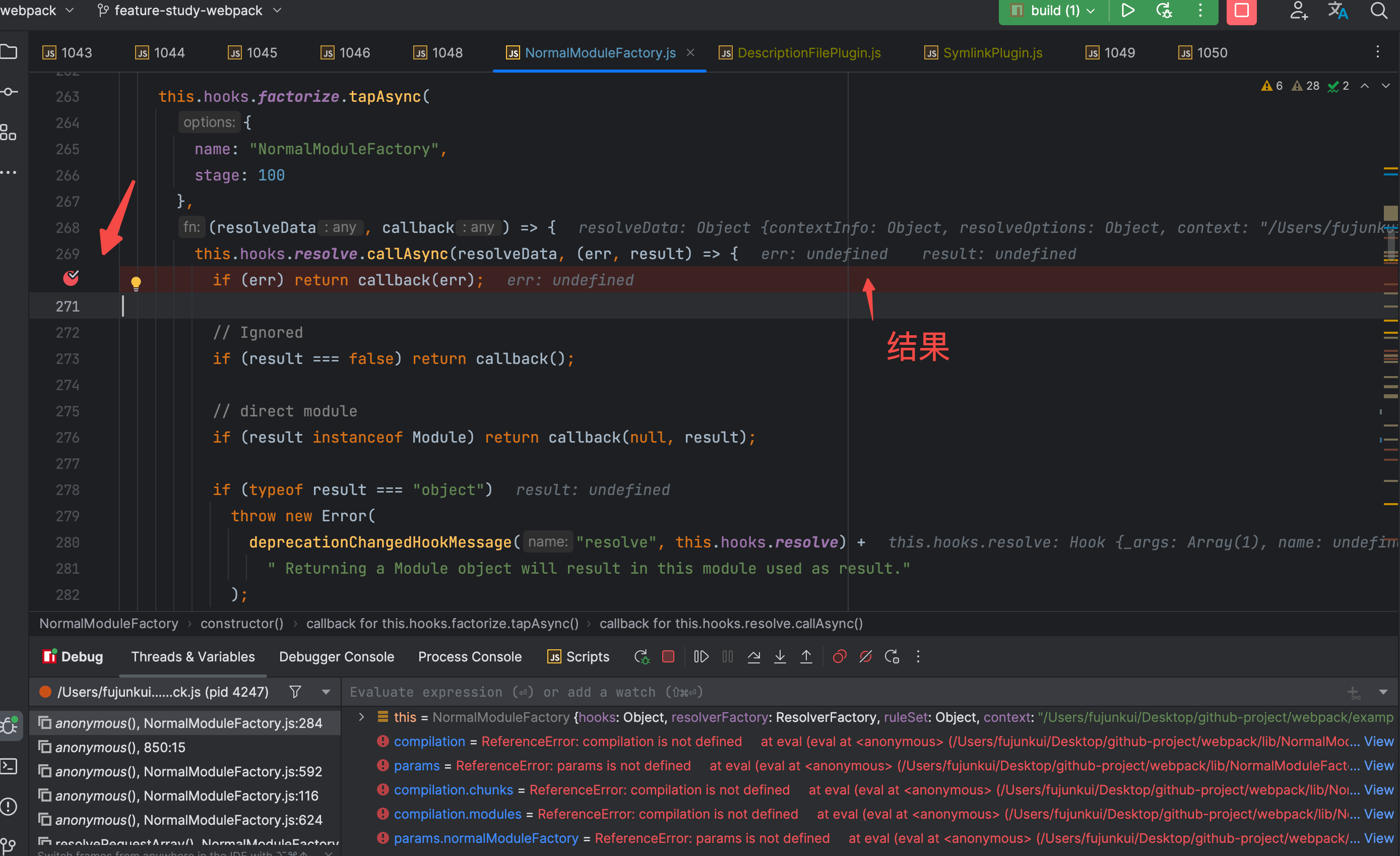 这样就可以跳过
这样就可以跳过continueCallback的部分,
2.5 进入 resolve hook 的内部
继续断点
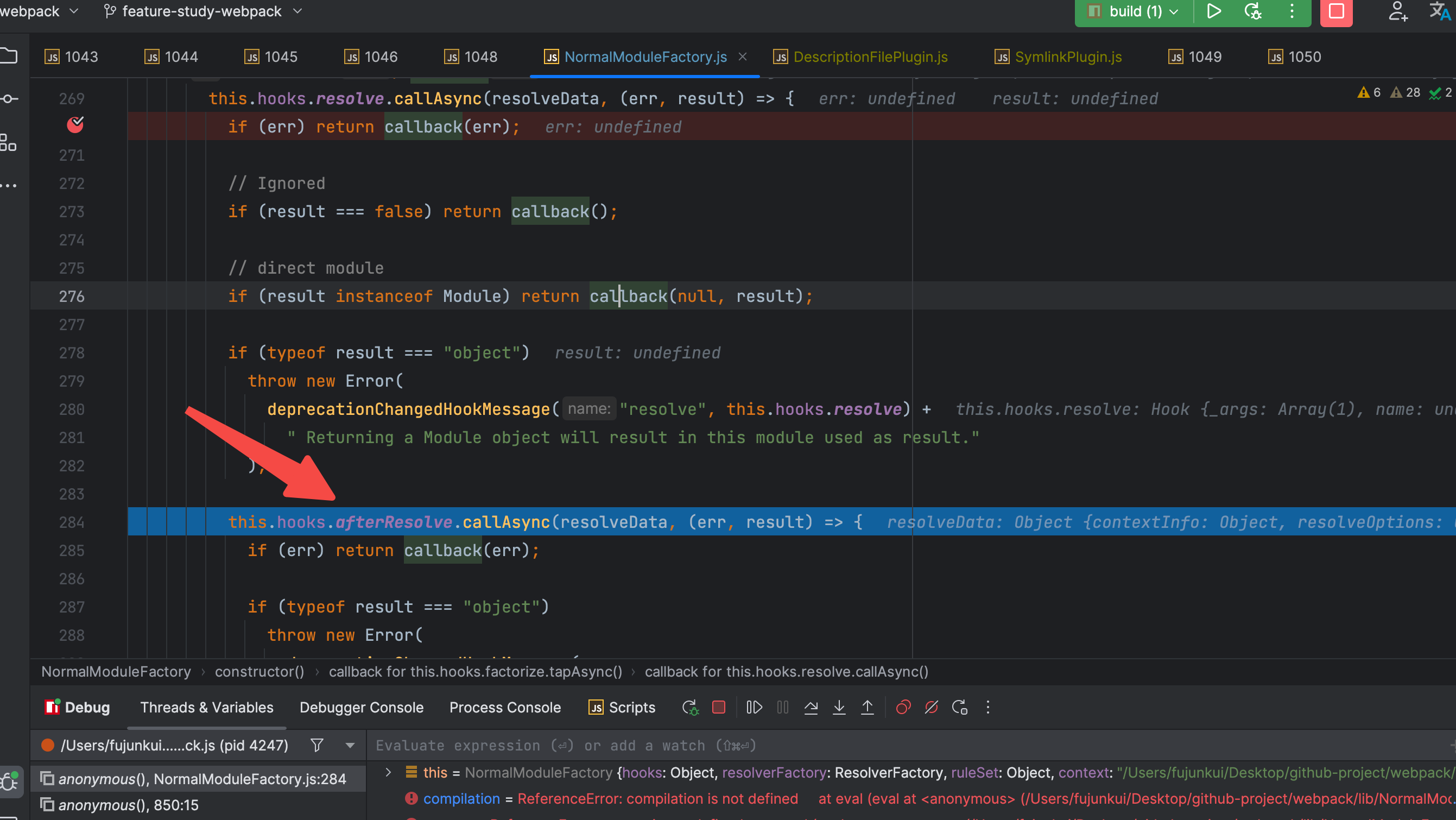
因为 err 和 result都为空,最后走到了afterResolve的 hook 里。 大家都应该会调试了,直接说结果了,没有插件去监听afterResolve的 hook,所以直接进其内部了。
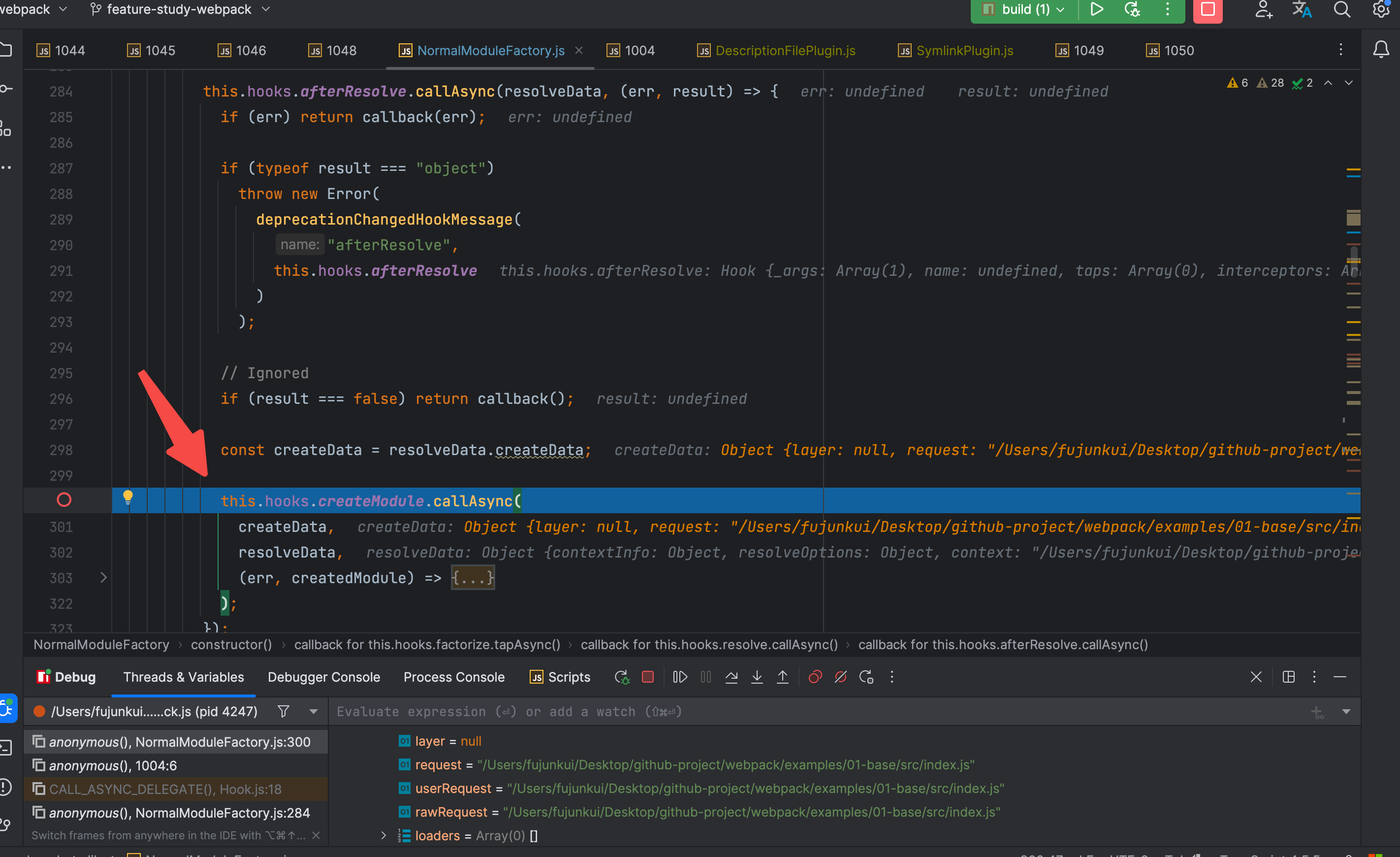
进入此 hook 内部以后,又是一堆的错误判断,最后走进了 createModule 的 hook。
2.6 进入 createModule 的 hook 【将路径等信息变为 Module】
此 hook 还是无插件监听,直接上图看其 callback 做了啥:

此处对整体的 webpack 来说是比较核心的,将路径代表的文件给变成了模块化的Module对象。(读者可以好好理解其背后的含义)
至于 Module 对象 不是本章的重点,这里只需要明白 路径代表的文件变为了 Module对象 即可。 然后继续向下执行,调用 module的 hook。直接看注册此 hook 的SideEffectsFlagPlugin插件。
Webpack 5 中的 SideEffectsFlagPlugin 主要用于优化项目的构建速度和代码体积。它能够在打包时根据配置文件中的 "sideEffects" 属性,自动确定哪些模块是有副作用的(即会对全局状态产生影响),哪些模块是纯粹的(即不会对全局状态产生影响)。当一个模块被判断为无副作用时,Webpack 5 会将其标记为 "side-effect-free",这样就可以进行一系列优化操作,如 tree shaking、scope hoisting 等,以减小最终打包出来的代码体积和提高加载速度。因此,通过合理配置 "sideEffects" 属性,并使用 SideEffectsFlagPlugin 插件,可以帮助开发者更好地优化自己的 Webpack 5 项目。
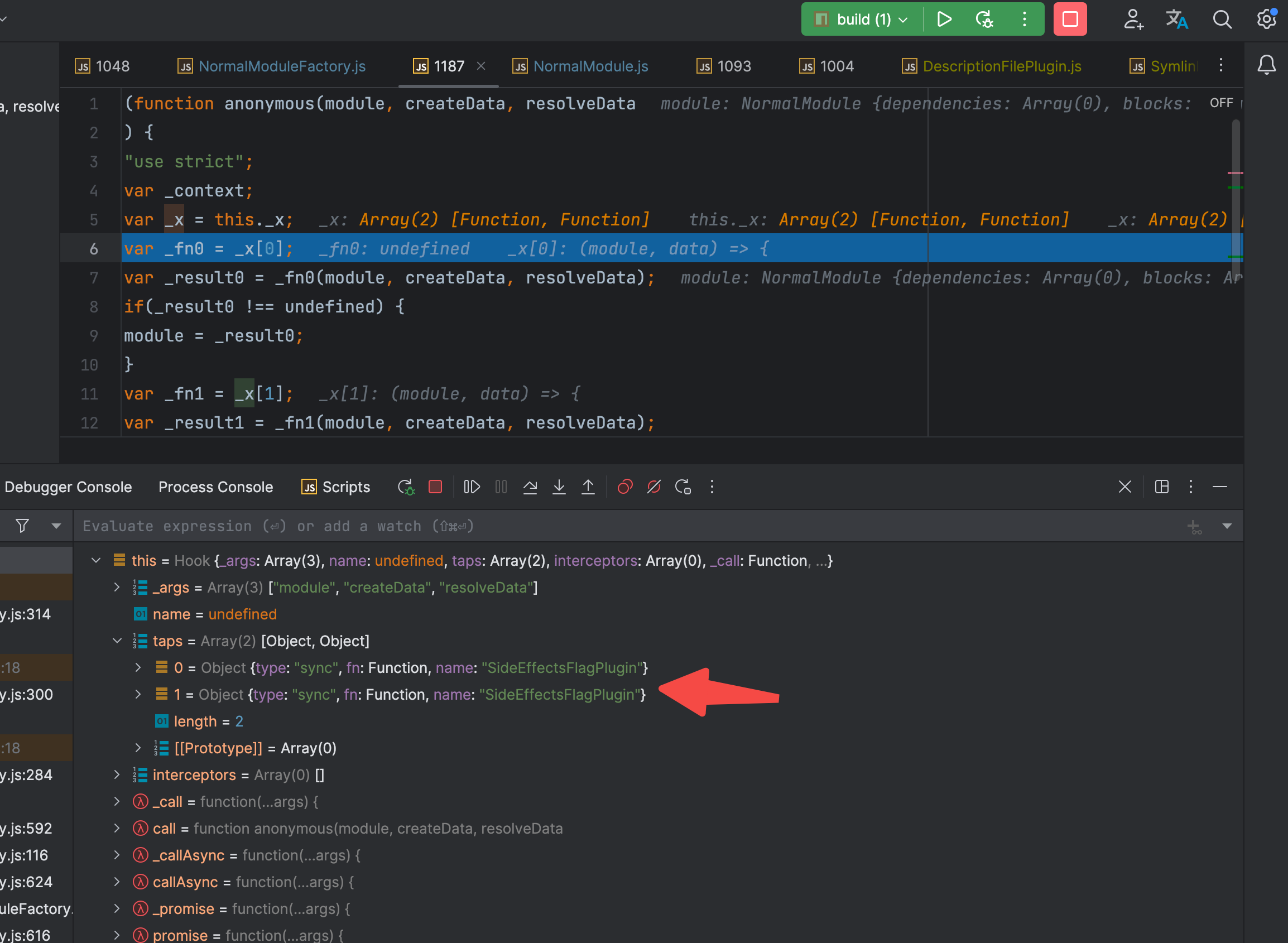
此插件里注册了两个监听函数。其执行结果如下:
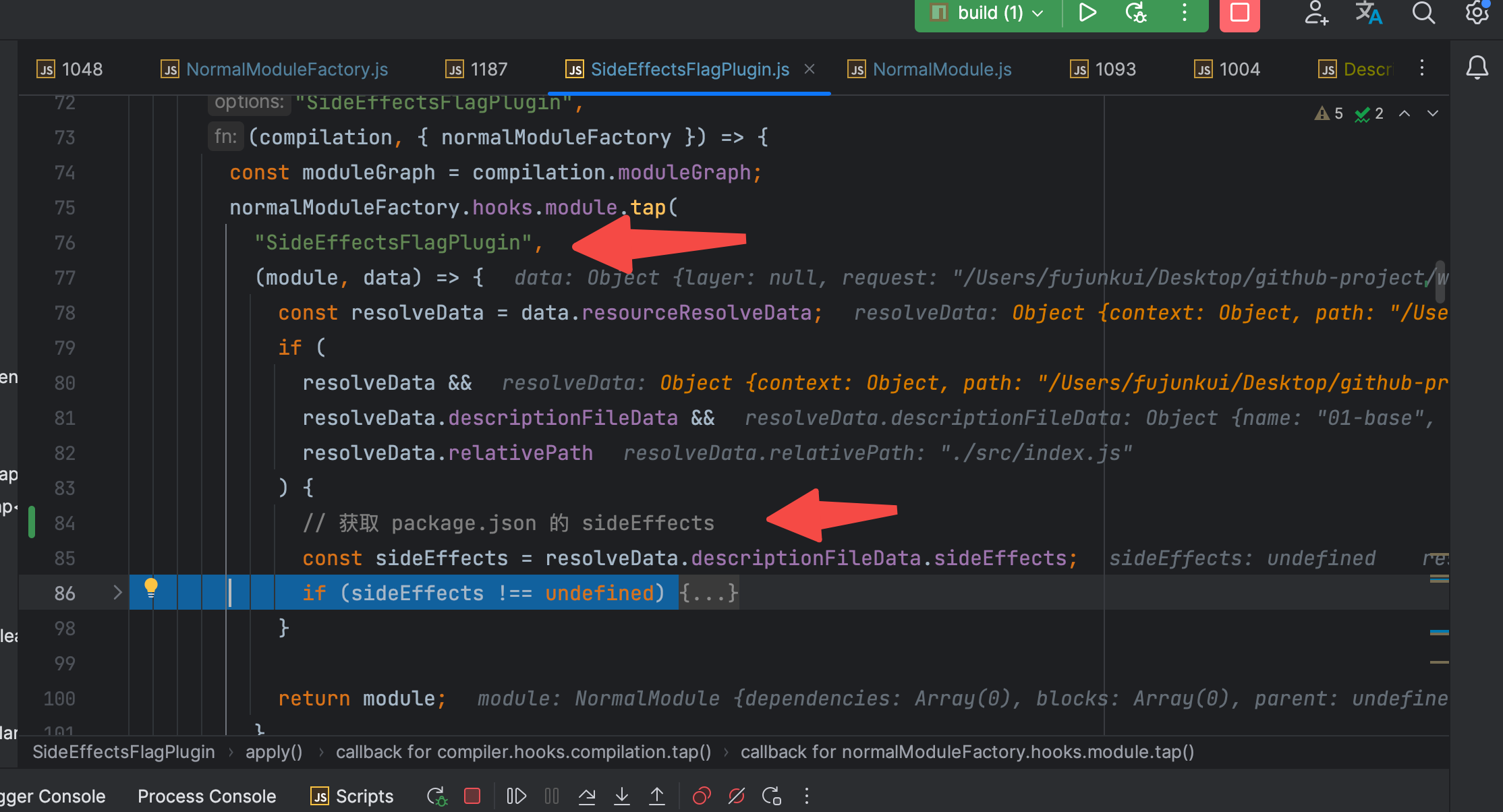
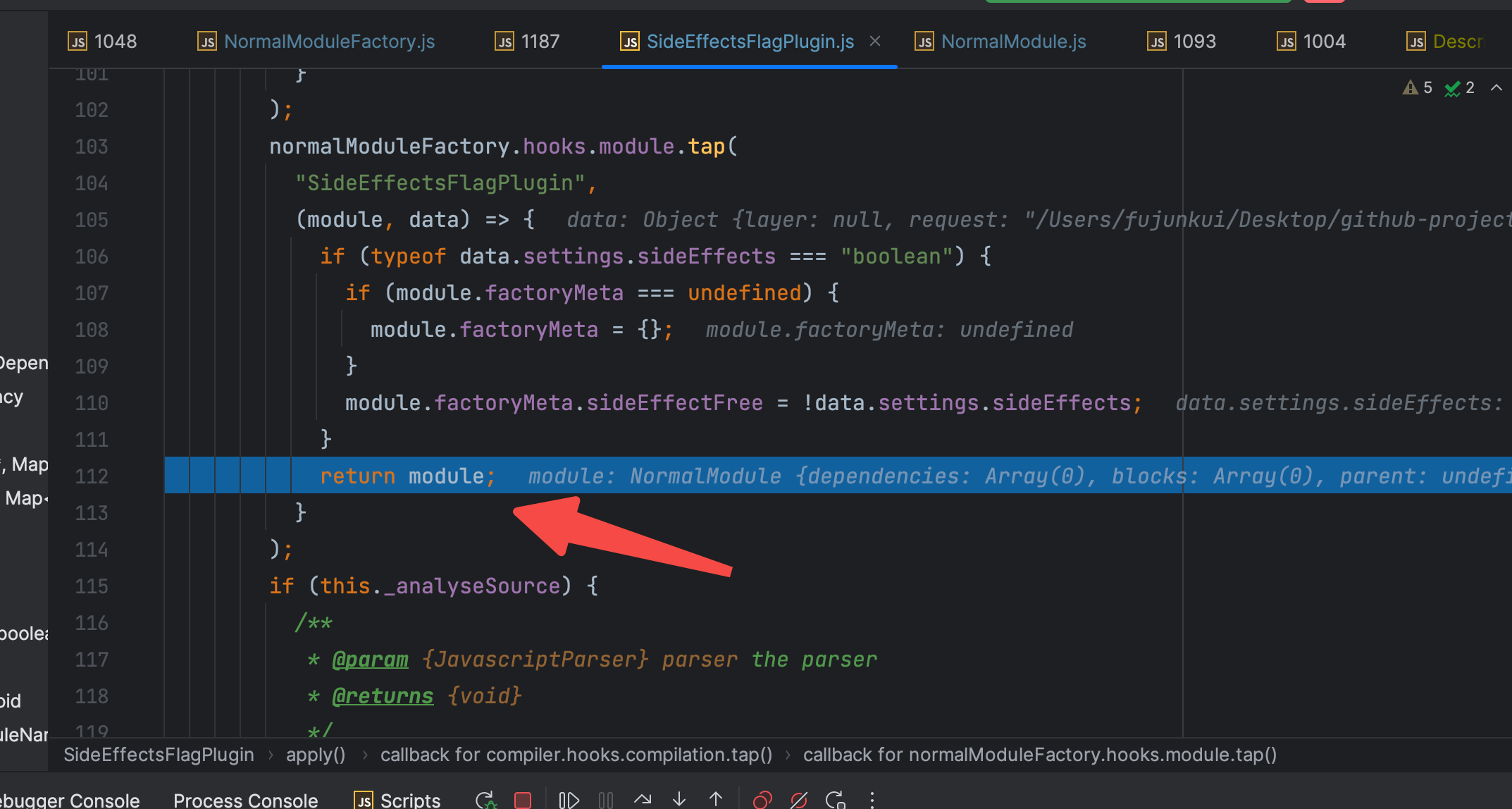
执行完毕,将根据路径创建的 module 实例通过 callback 传递出去。继续单步断点,看此 callback 会走进哪个 hook 里。
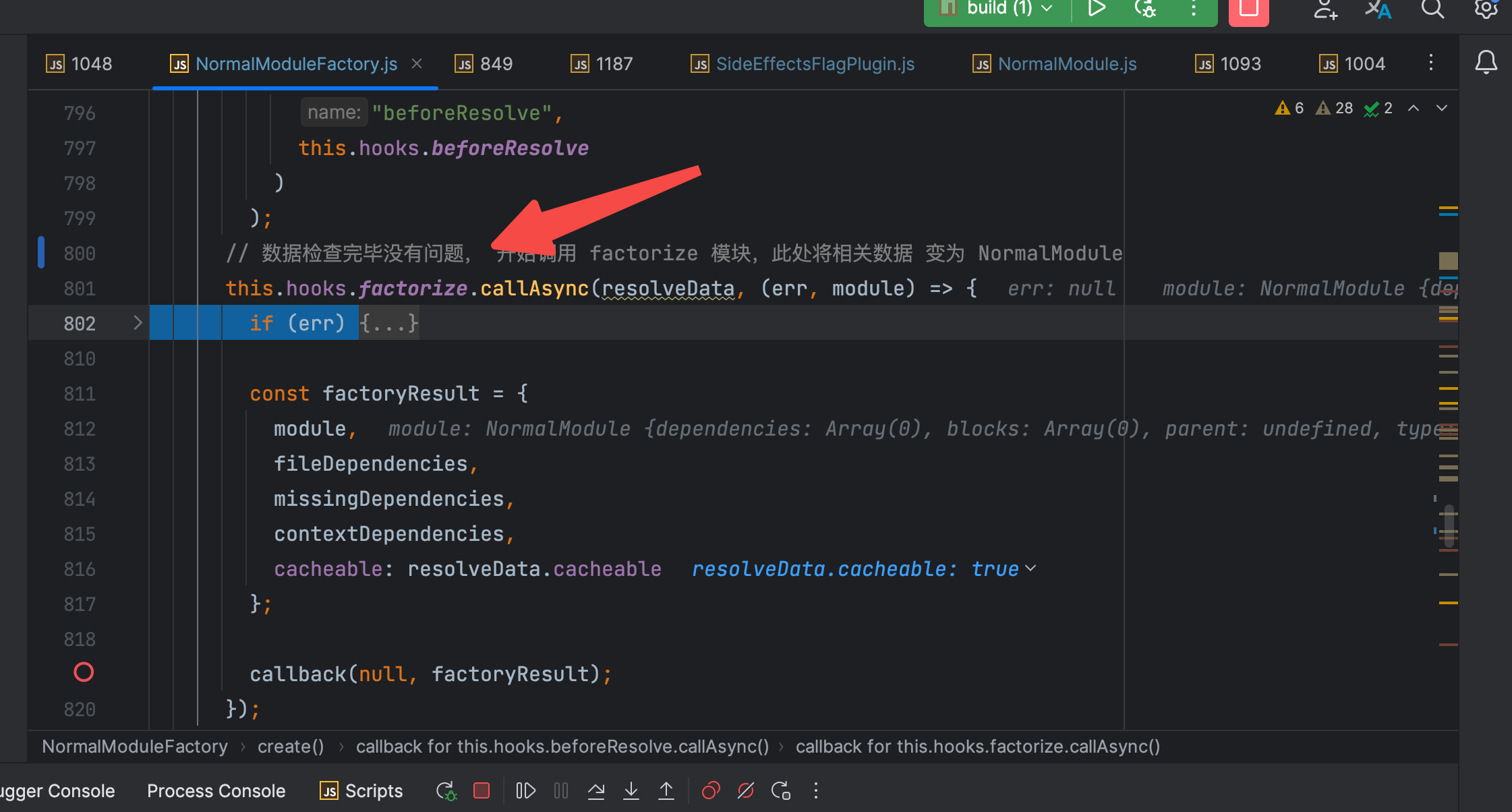
最后走进了 factorize 的 hook,
至此,实现了一个 文件变成了一个 Module 的过程。继续向下执行 callback,看下一步是做什么?
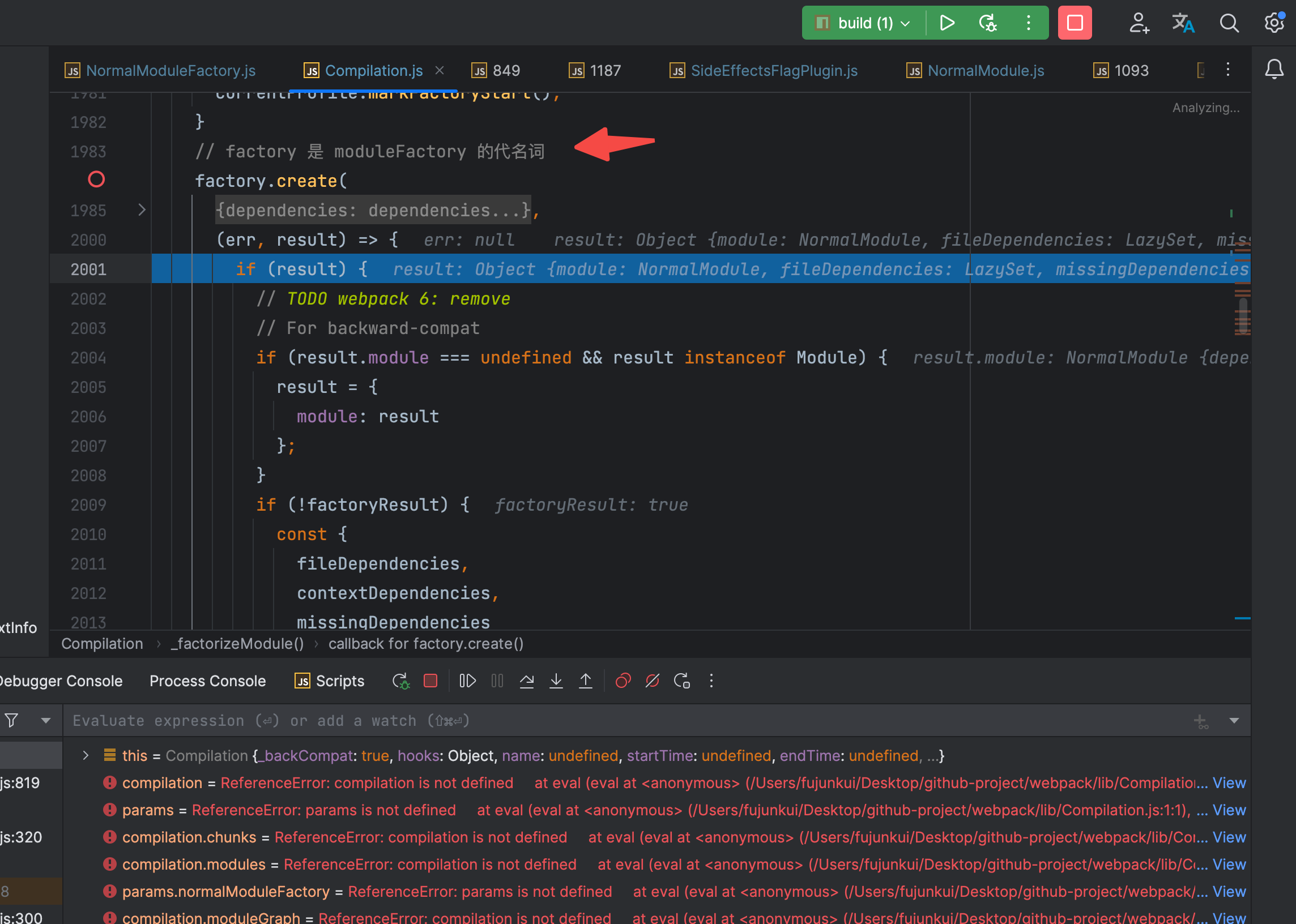
走到了 factory.create 的 callback 函数了,也就是 _factorizeModule方法。还记得这个方法是哪个队列的 processor方法吗? 贴上代码:
this.factorizeQueue = new AsyncQueue({
name: "factorize",
parent: this.addModuleQueue,
processor: this._factorizeModule.bind(this)
});
让我们继续执行下去,
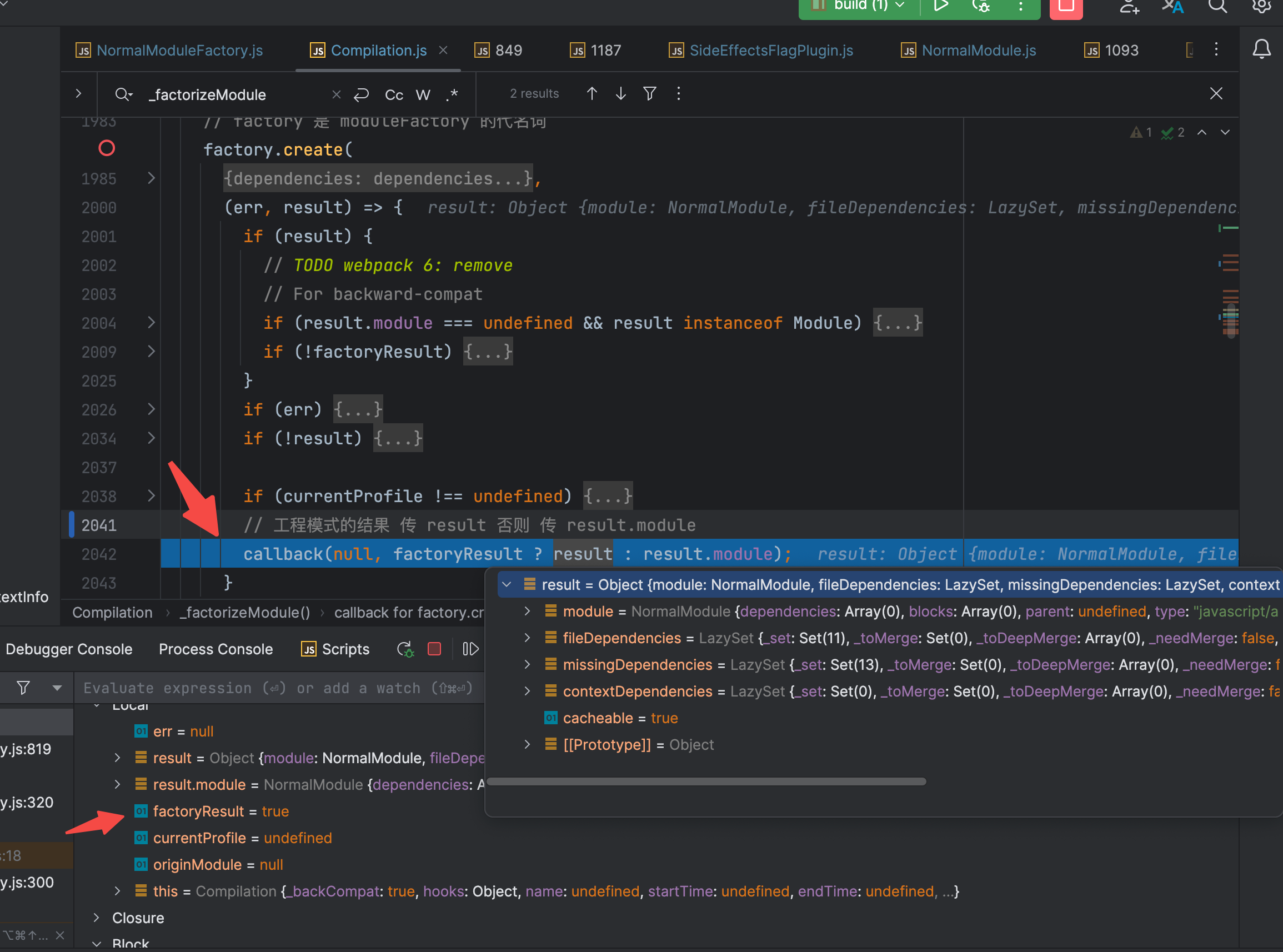 执行到
执行到 callback 里的 callback,继续进入此 callback(链路太长了,绕来绕去的)
进入到 AsyncQueue.js文件。
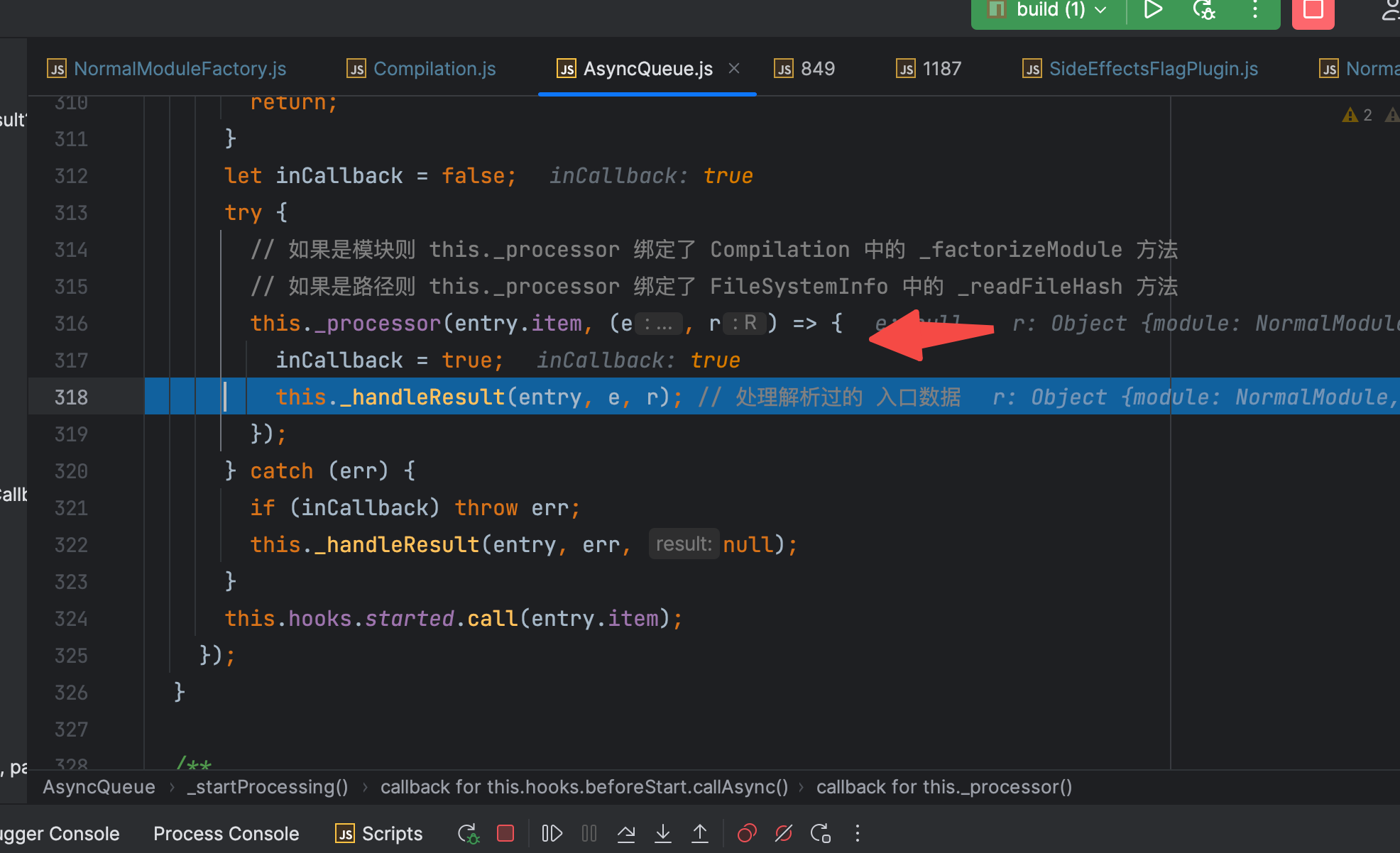 再调用
再调用 _handleResult 去处理_processor后的结果。
2.7 进入 _handleResult 方法
上图:

这个方法比较简单,直接调用了 result 的 hook,此 hook 也没有插件进行监听,直接执行自身的 callback 函数,进入 此 hook 的内部。
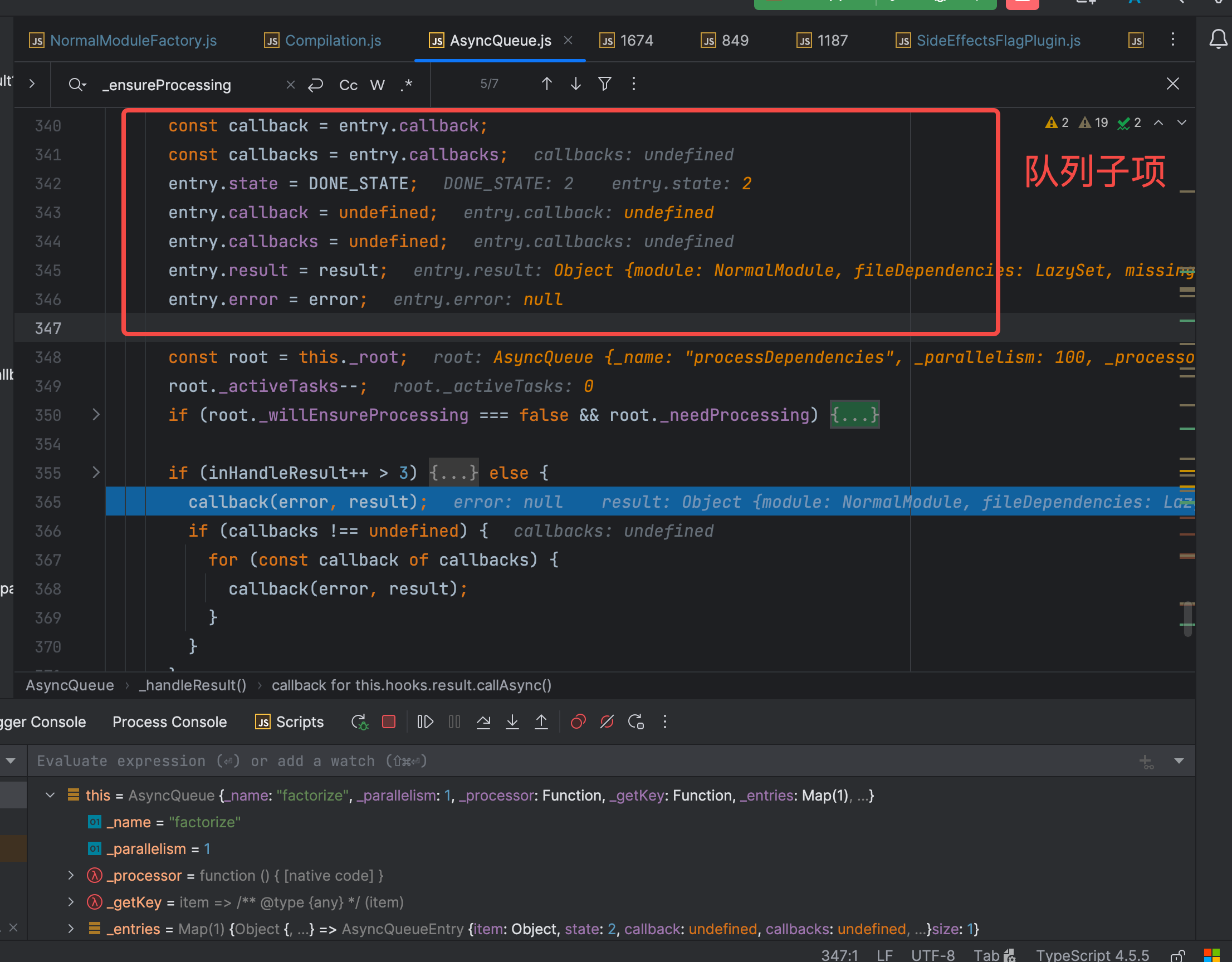
红色圈中部分,将队列子项AsyncQueueEntry的状态改为完成的状态。然后找到父级,将父级用于计数当前激活任务的值减一。
// 如果父级用有需要进行的任务并且父级需要去执行。就把相关任务添加进异步里。
if (root._willEnsureProcessing === false && root._needProcessing) {
root._willEnsureProcessing = true;
setImmediate(root._ensureProcessing);
}
当前父级不需要执行什么任务,此处跳过。继续向下执行。
if (inHandleResult++ > 3) {
process.nextTick(() => {
callback(error, result);
if (callbacks !== undefined) {
for (const callback of callbacks) {
callback(error, result);
}
}
});
} else {
callback(error, result);
if (callbacks !== undefined) {
for (const callback of callbacks) {
callback(error, result);
}
}
}
此时的 inHandleResult 判断没有走进 if 分支,走到 else 分支。这里你会发现不管走进那个条件里,核心代码都是一样的,唯一的区别在于是否包裹在process.nextTick里。
继续调试下去,执行callback(error, result);,此处的 callback是从 AsyncQueueEntry身上取到的。回想一下这里的 callback的来源是哪里?
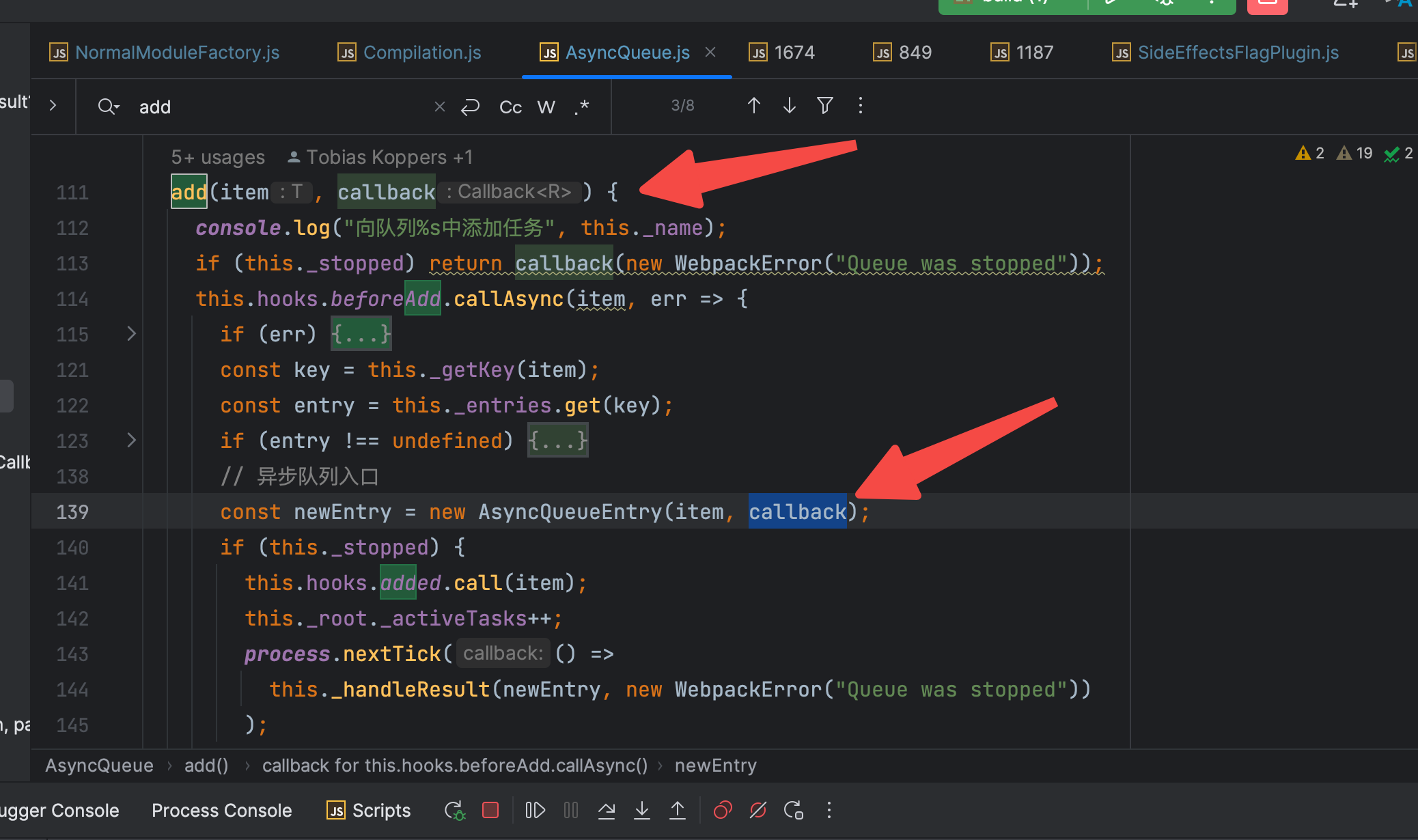
是AsyncQueue 调用add时候传入的 callback 函数。
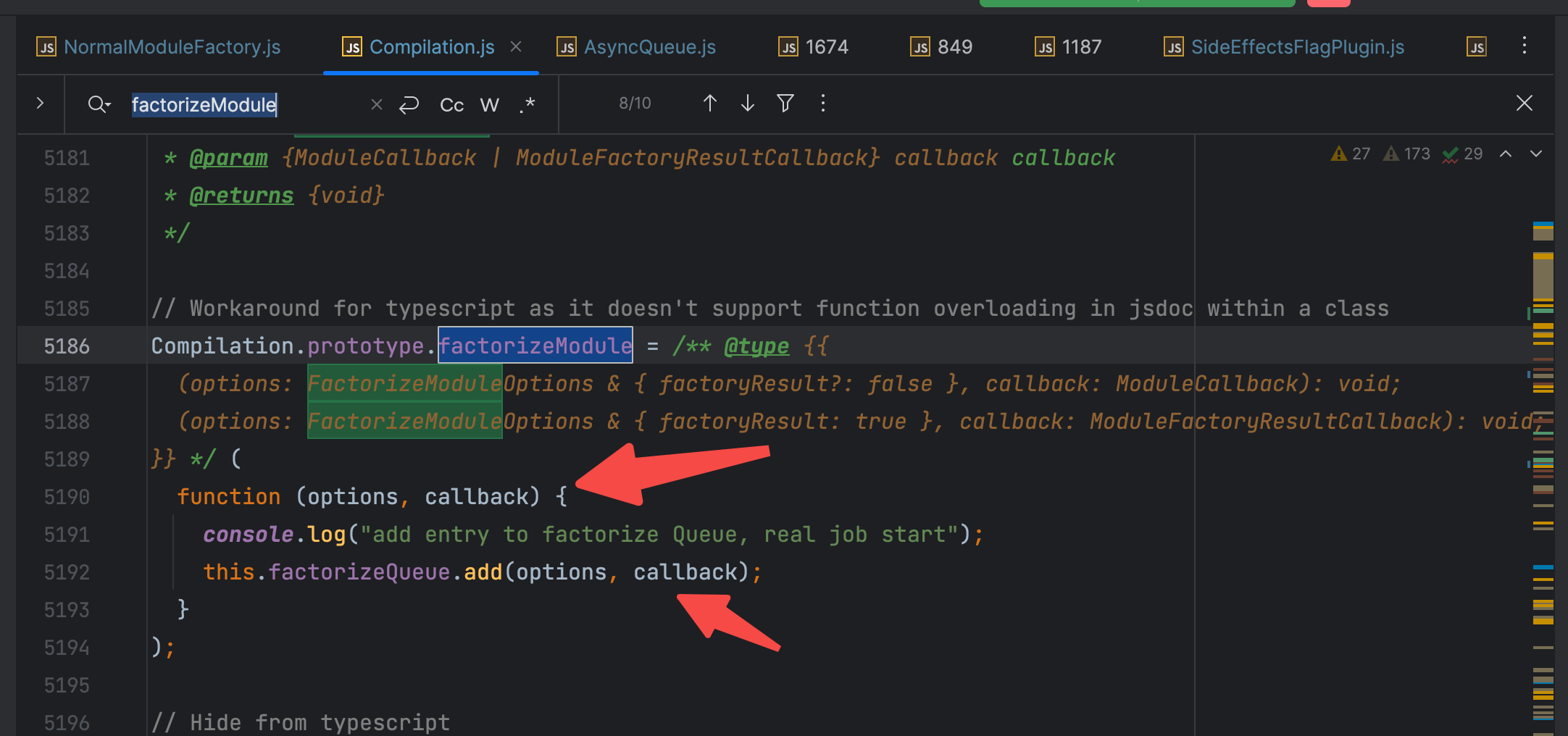
回想一下调用这个方法的位置:
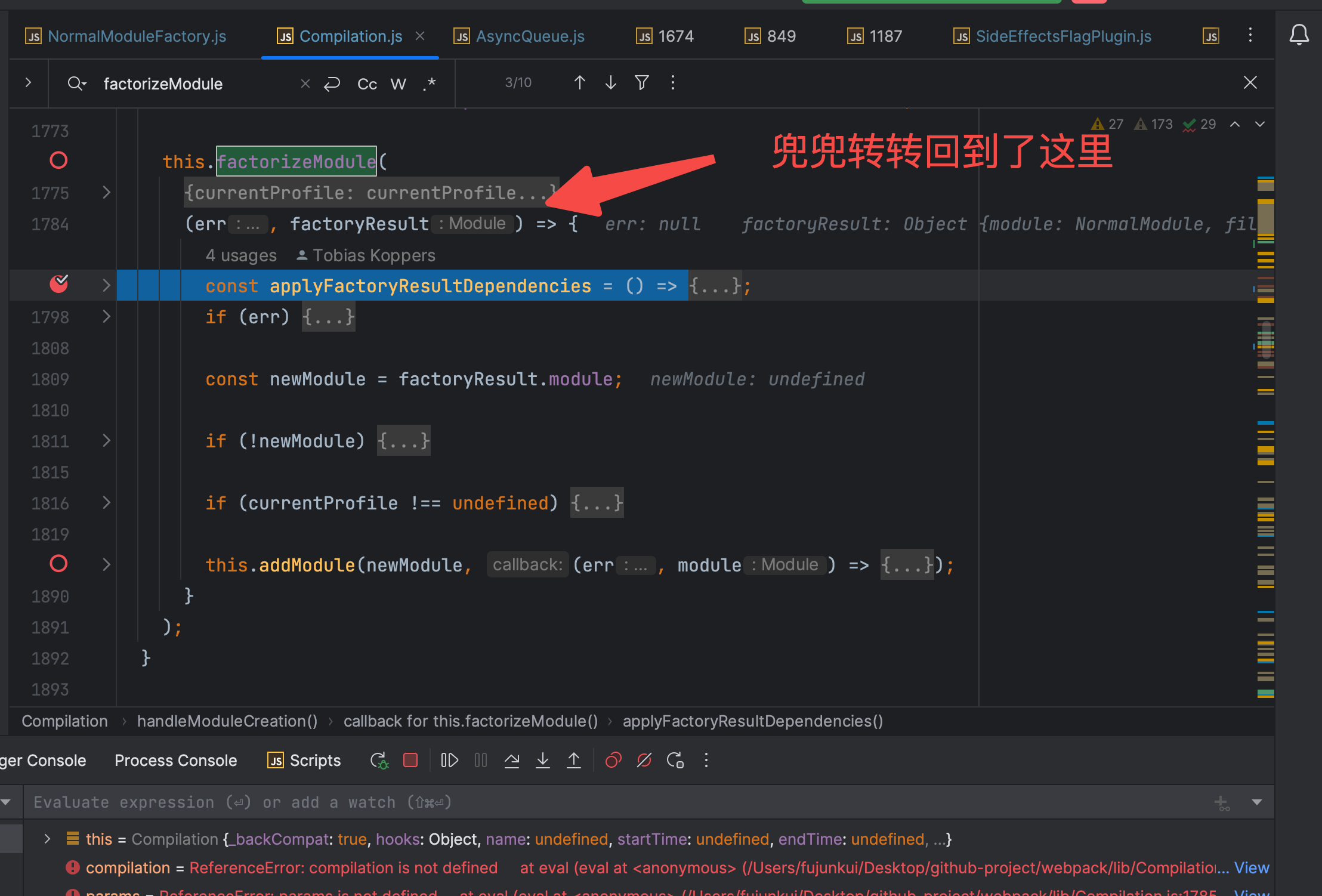
兜兜转转的,又回到了 Compilation.js 这个文件。继续调试,大概率是要进入 addModule这个方法的。
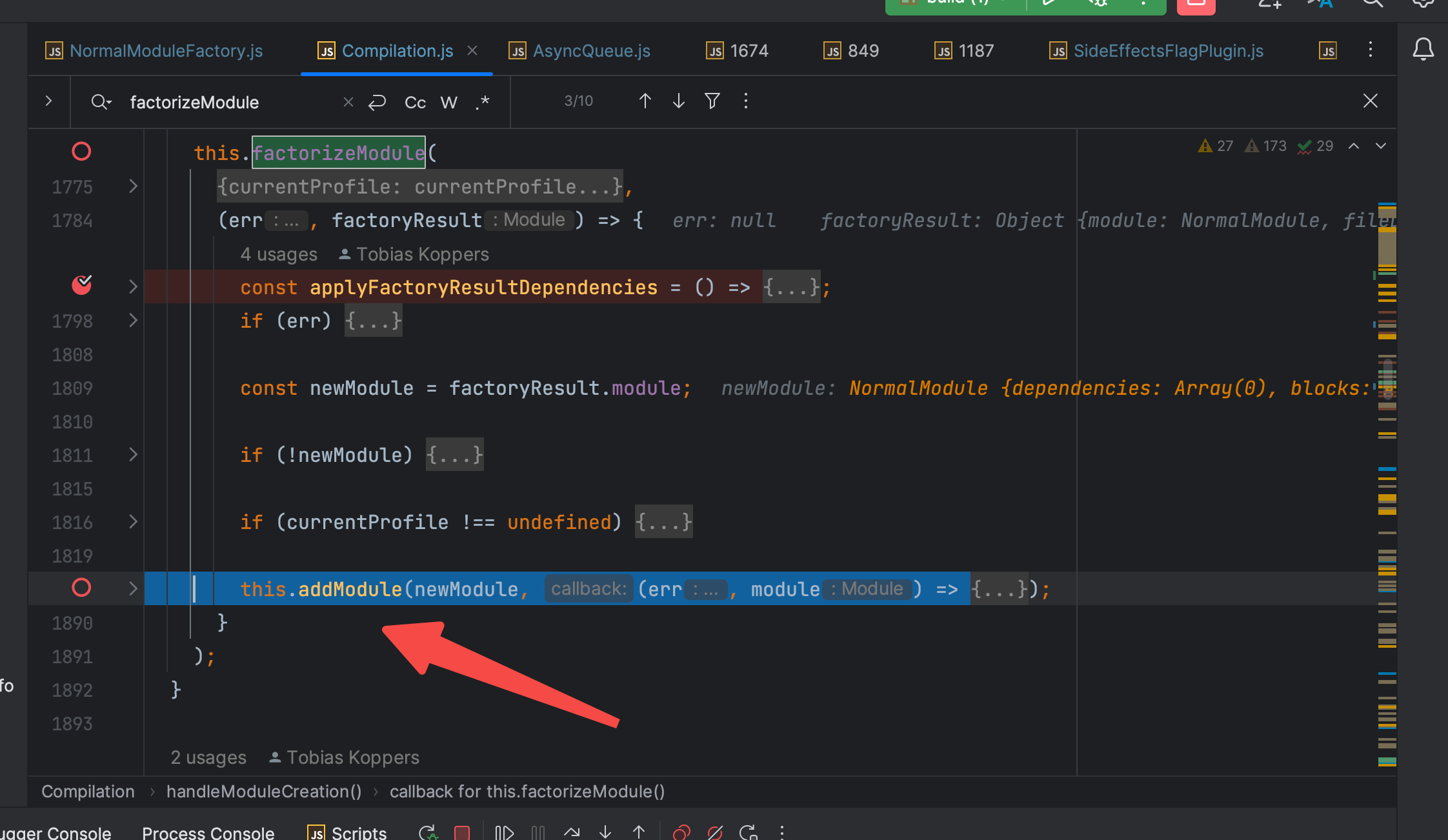
addModule(module, callback) {
this.addModuleQueue.add(module, callback);
}
看到这个代码,感觉是不是有些相似,又回到了本文(梦)开始的地方。
关于addModuleQueue.add后,接下来的路,各位读者,还需要我再出一篇文章去解析吗?有需要的读者,可以在评论区评论告诉我哈。毕竟每个 AsyncQueue 里的具体执行内容不一样。
